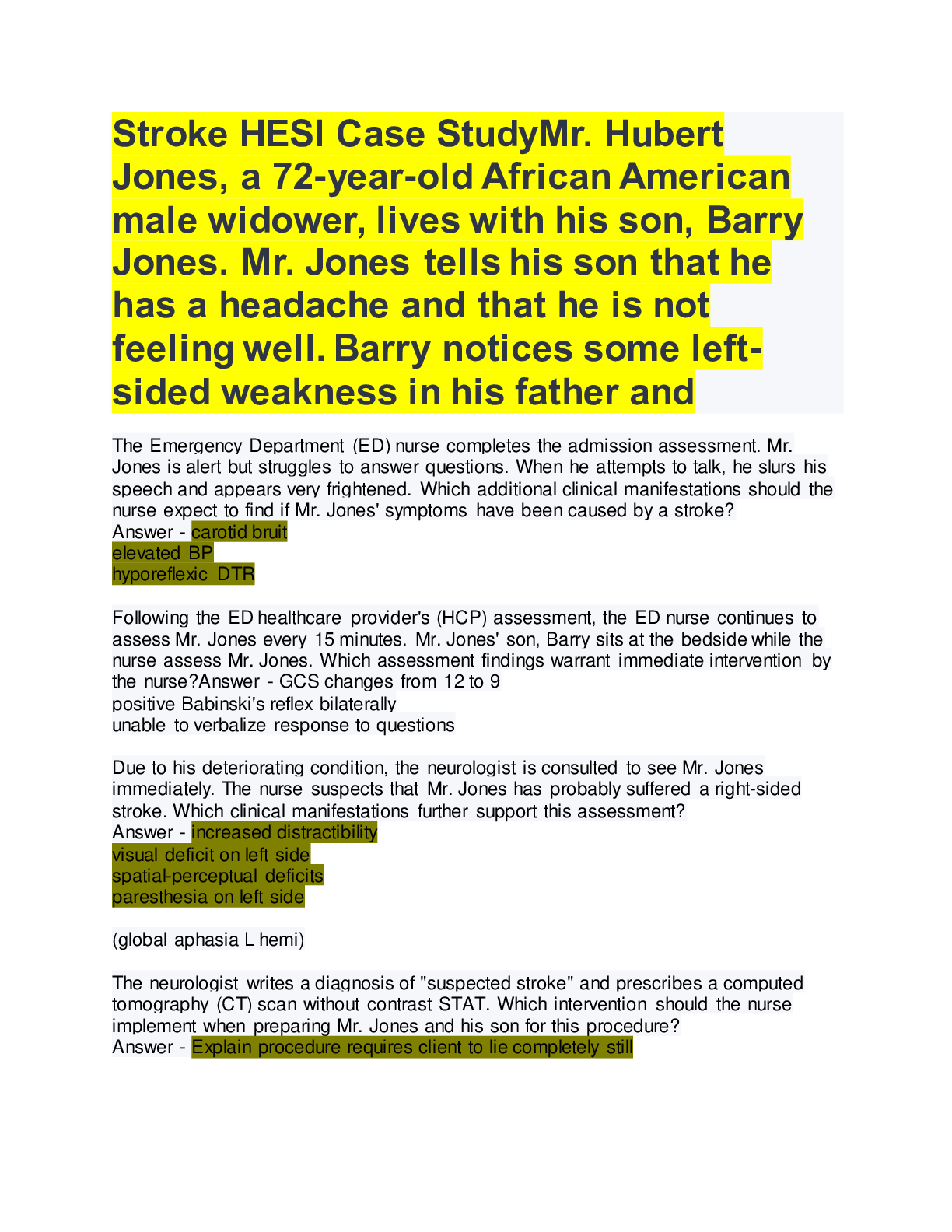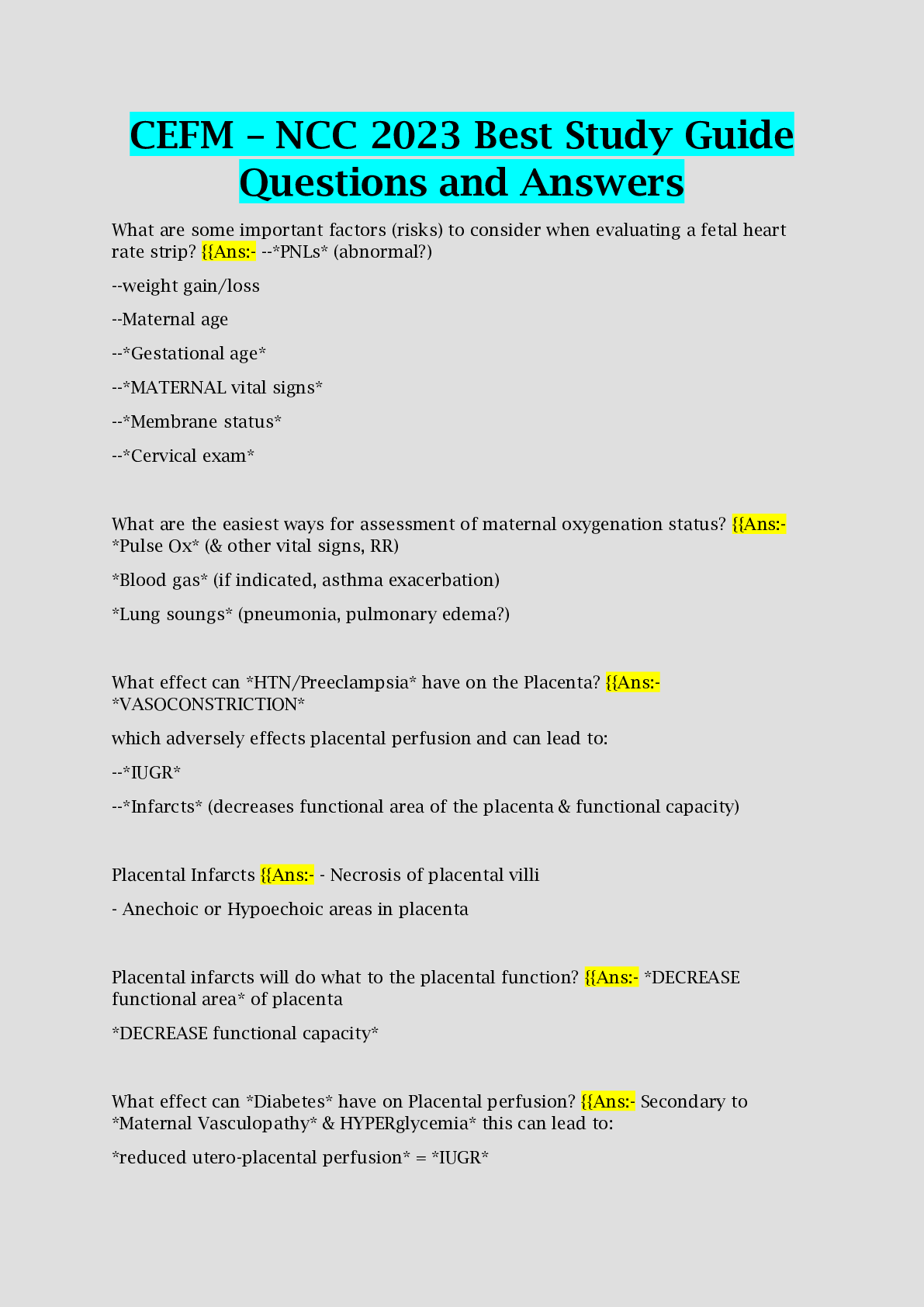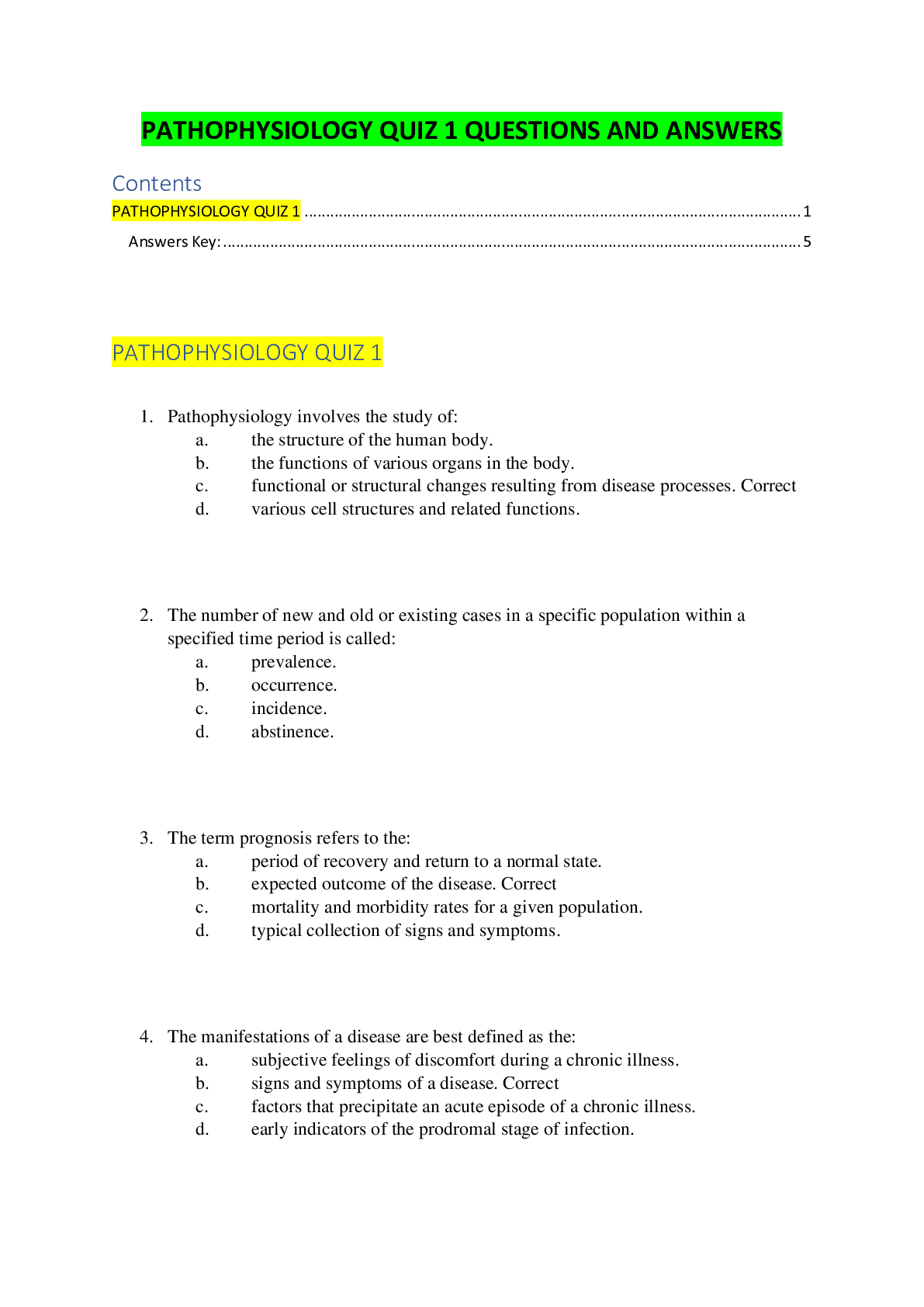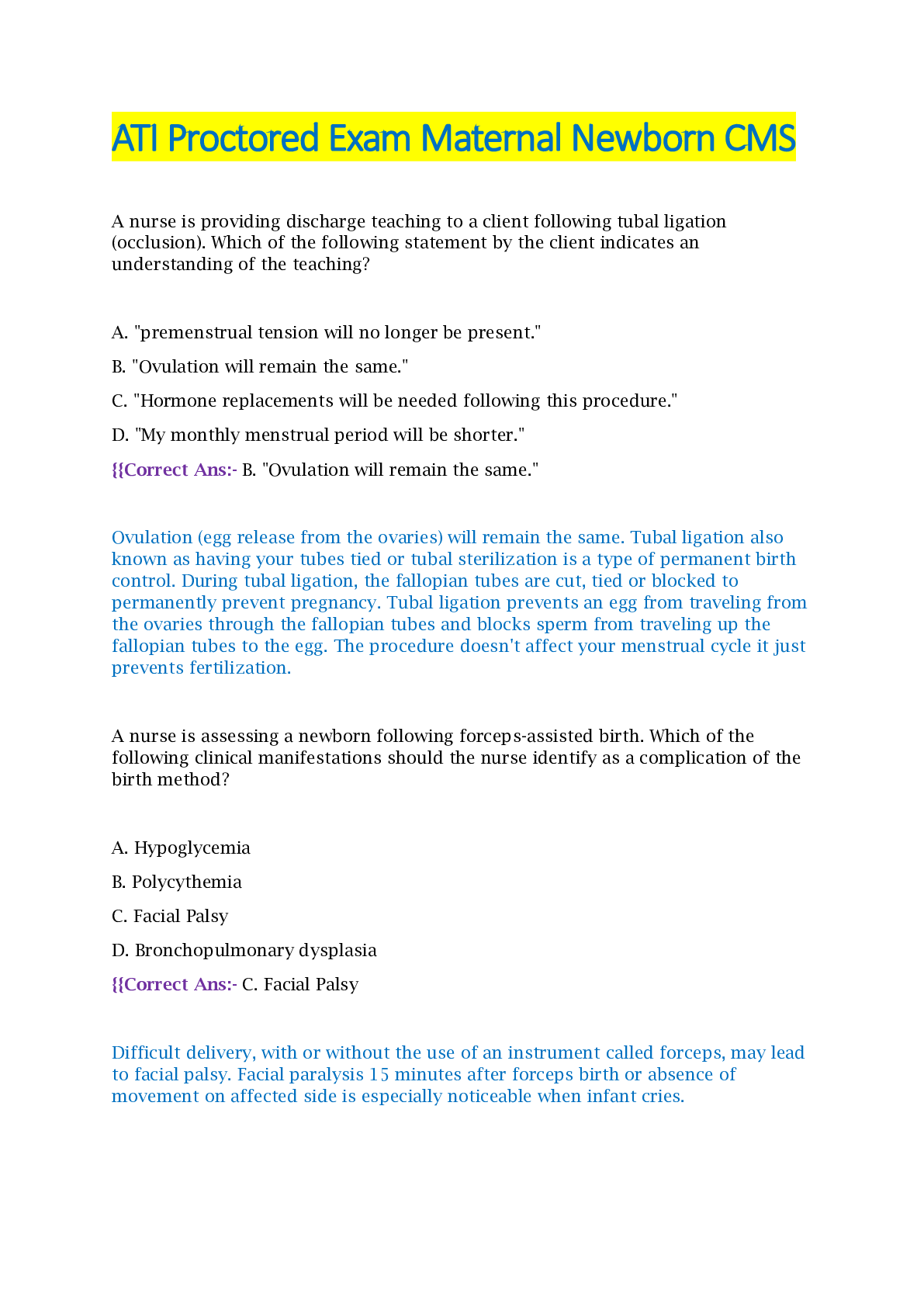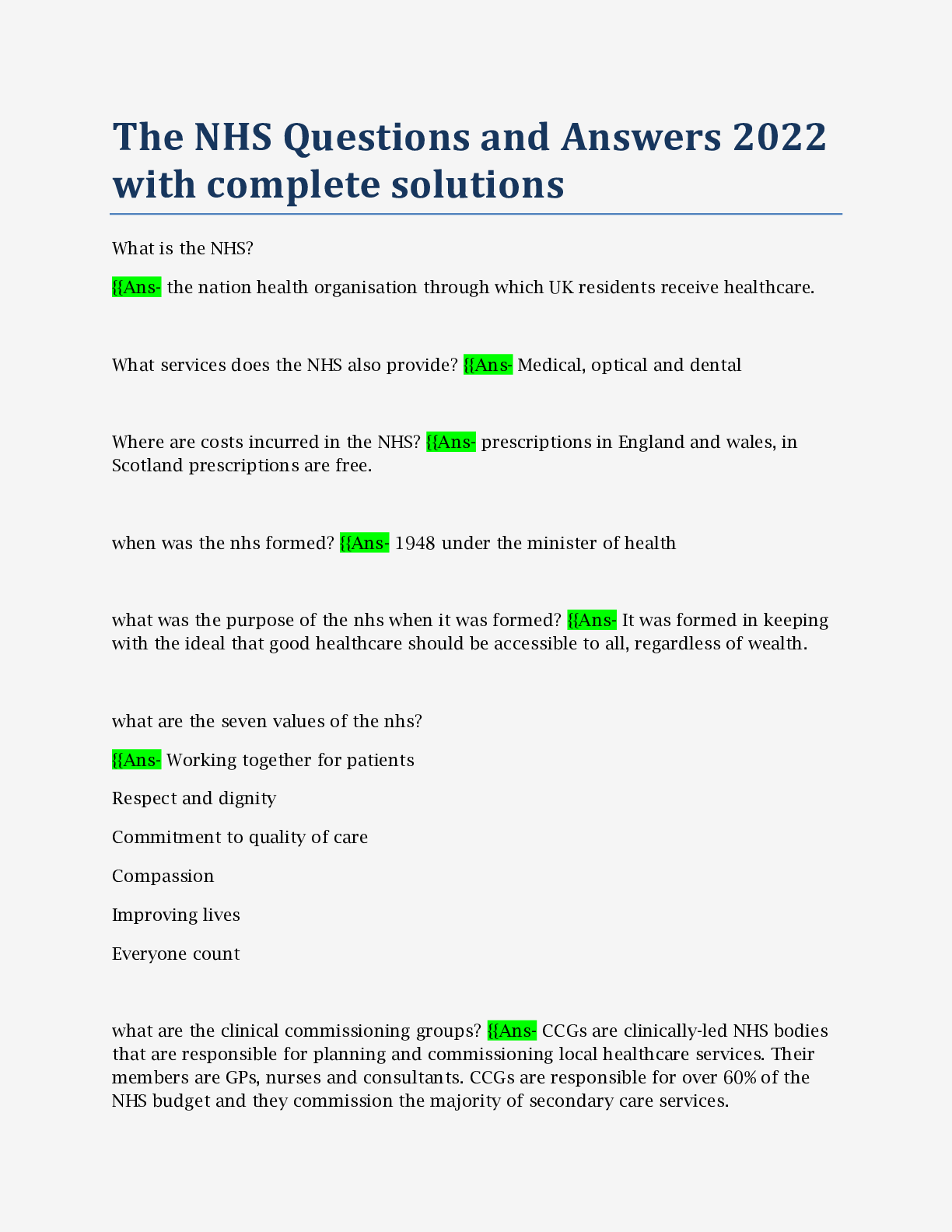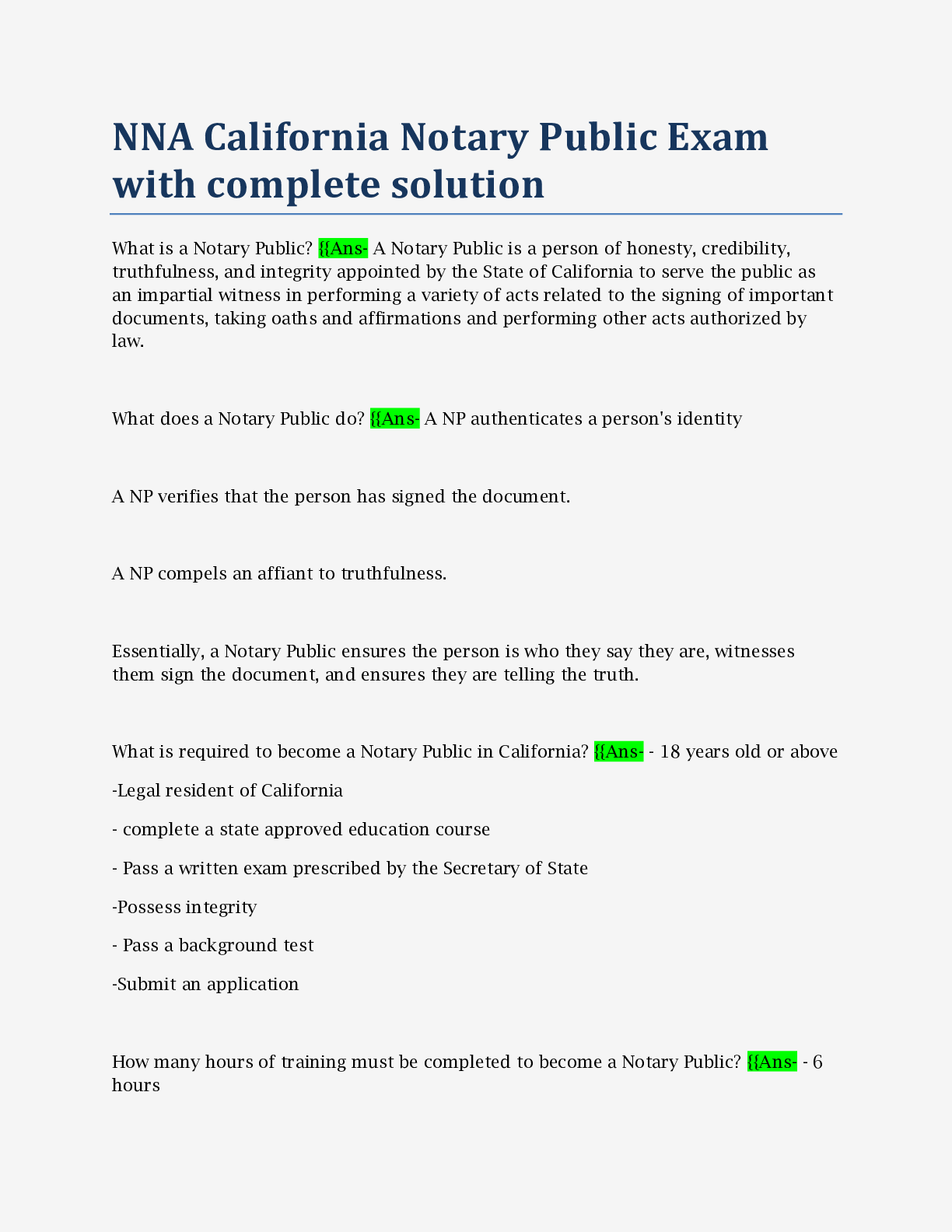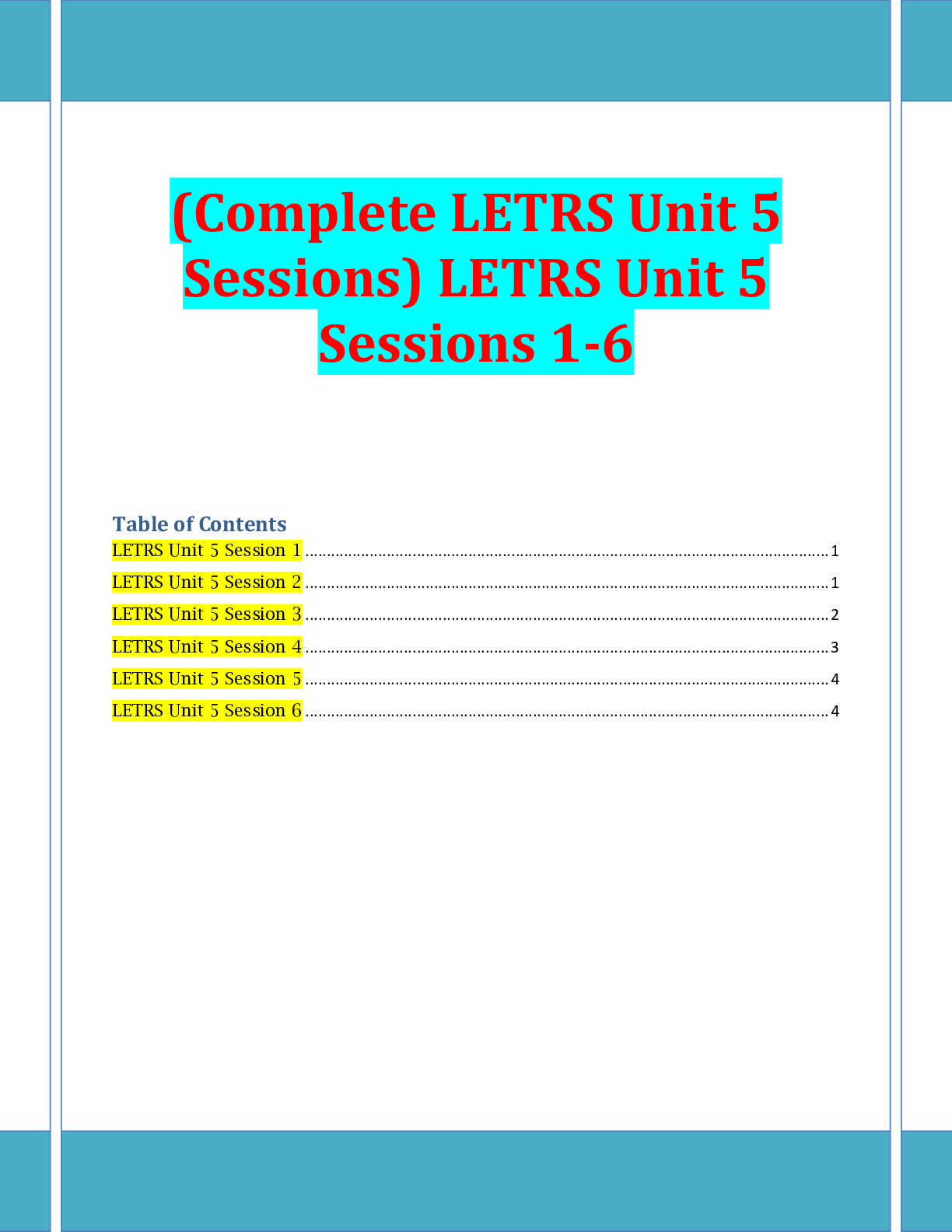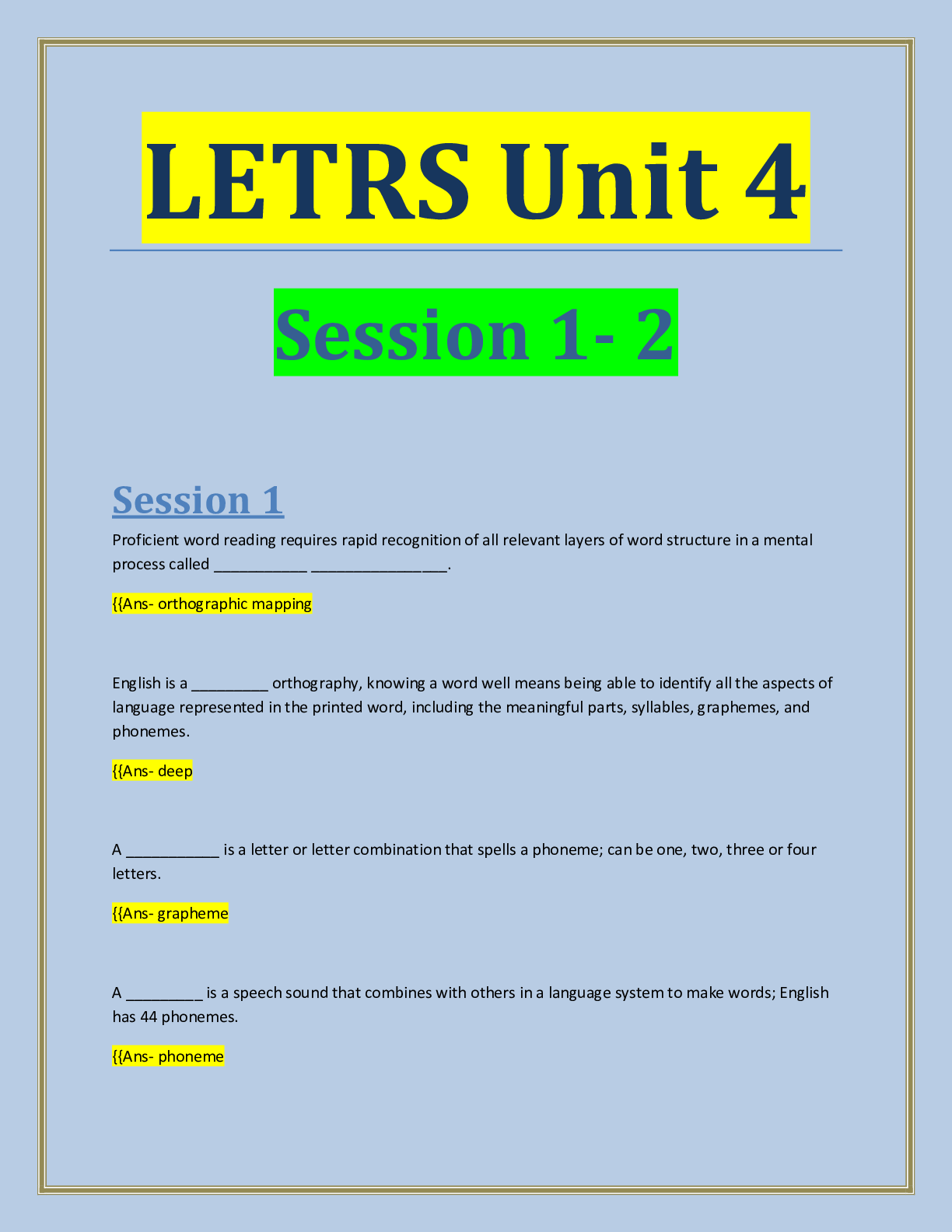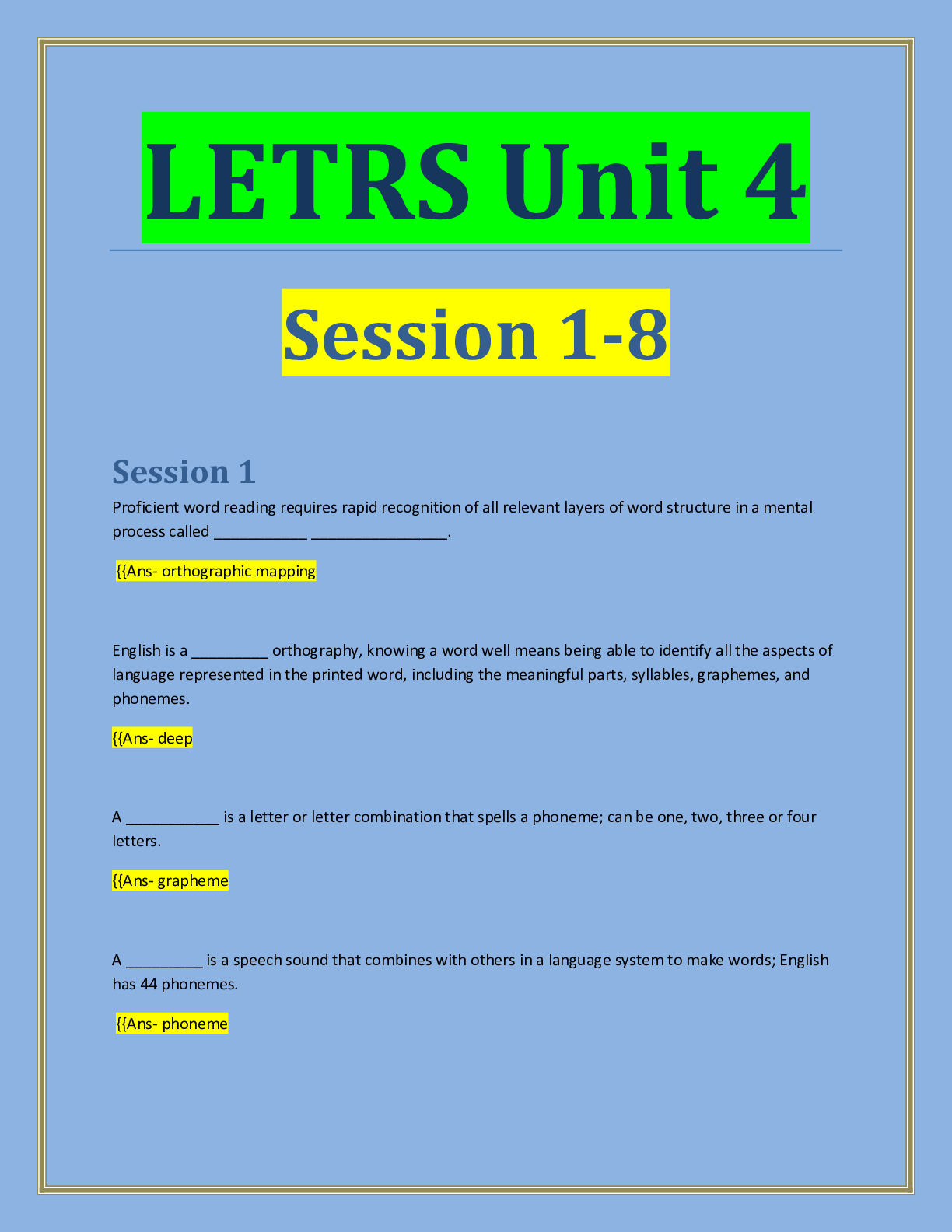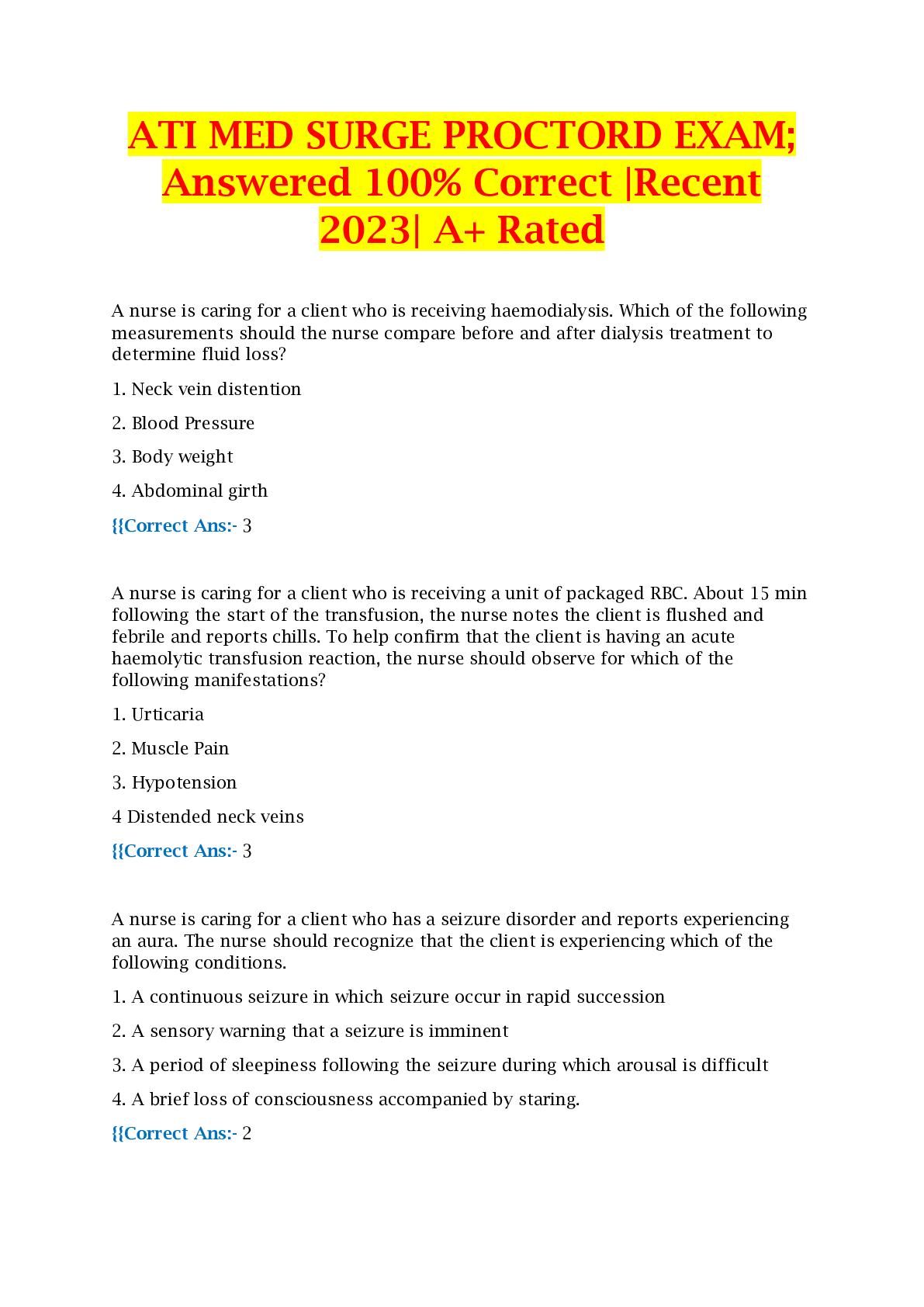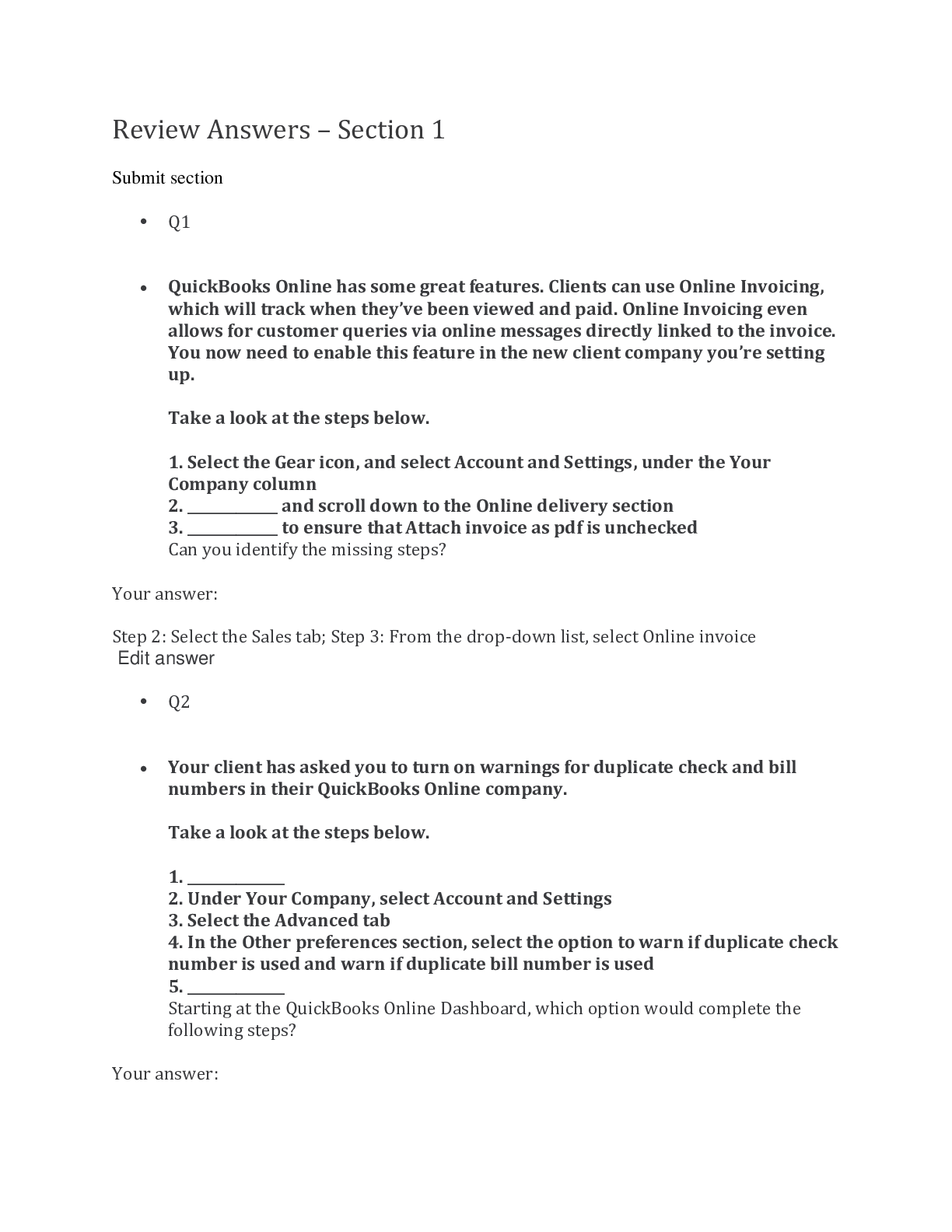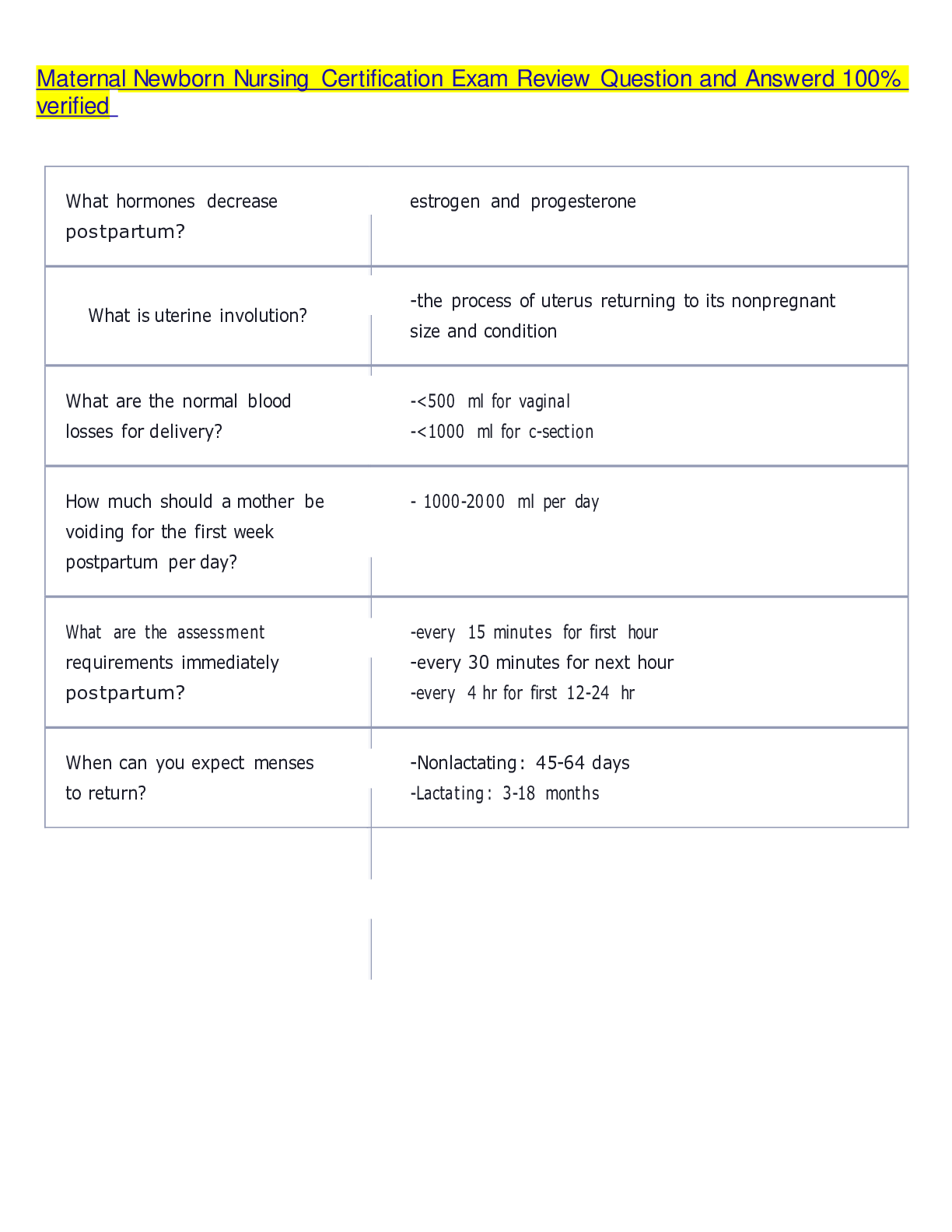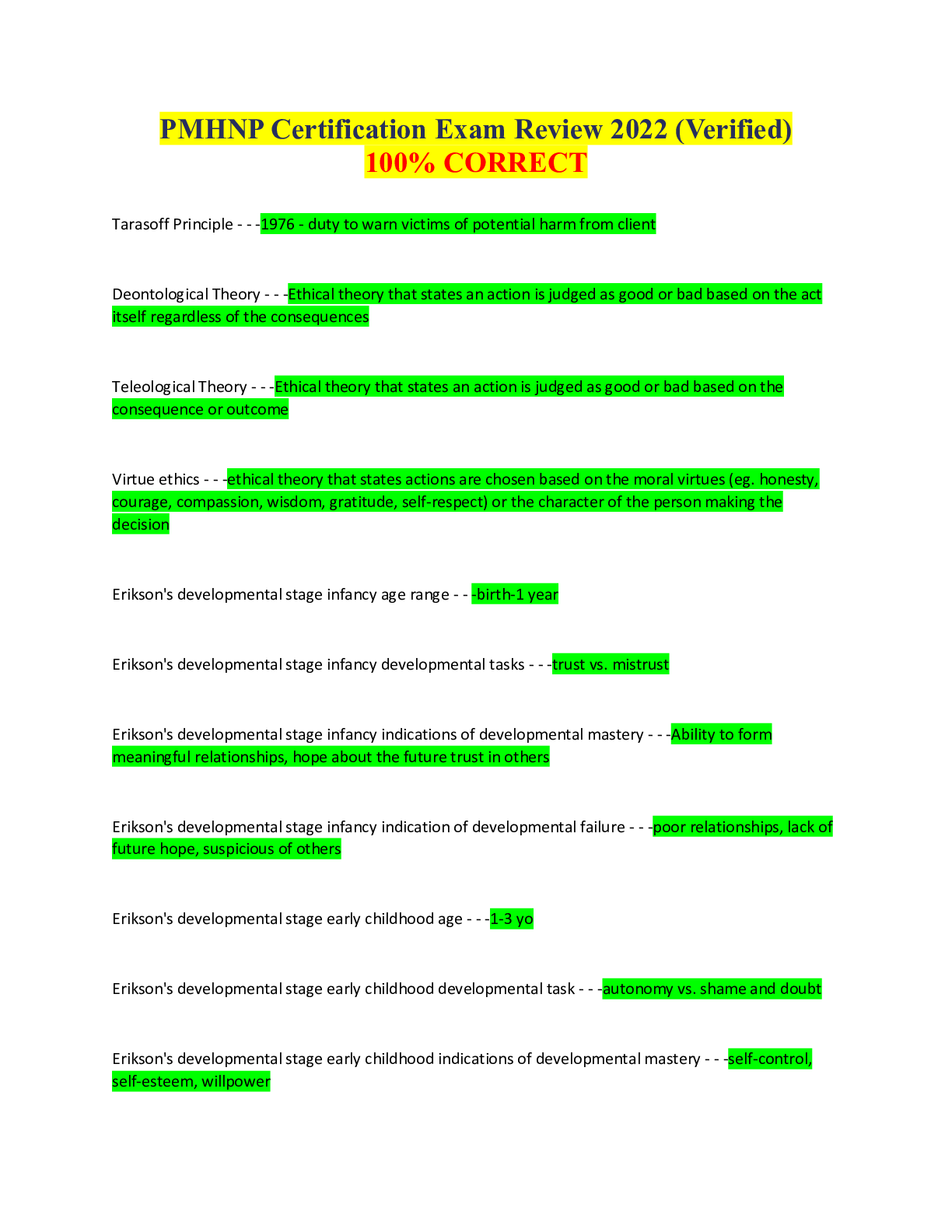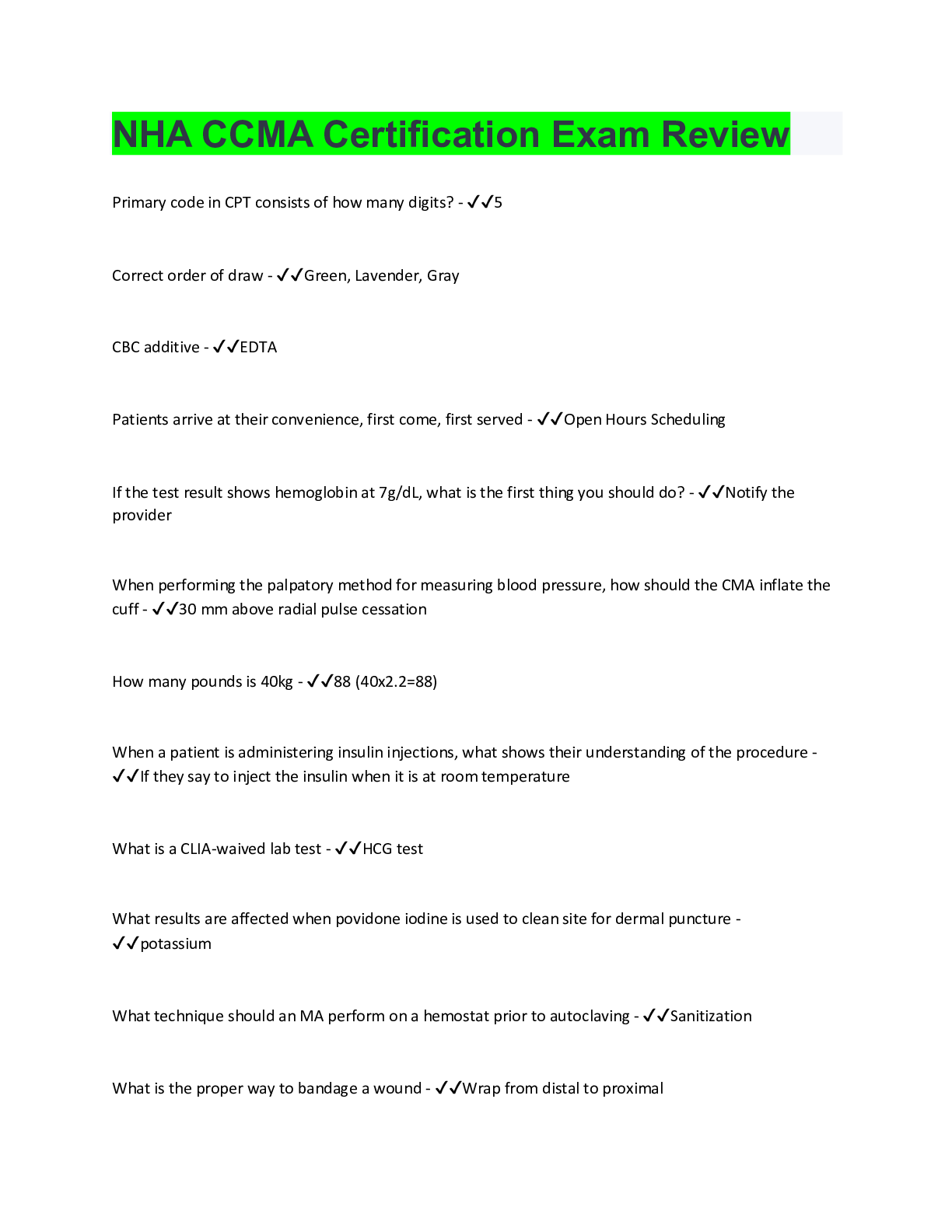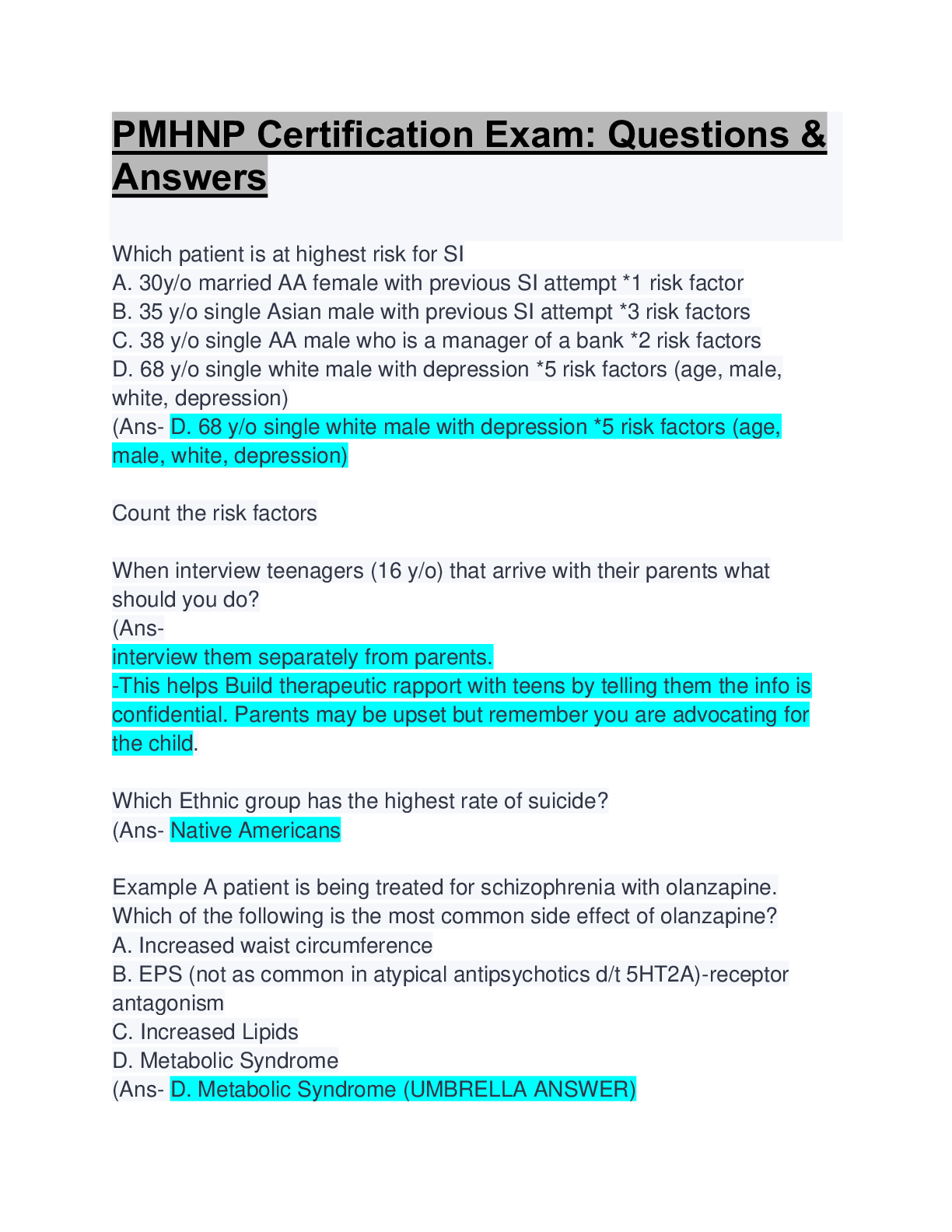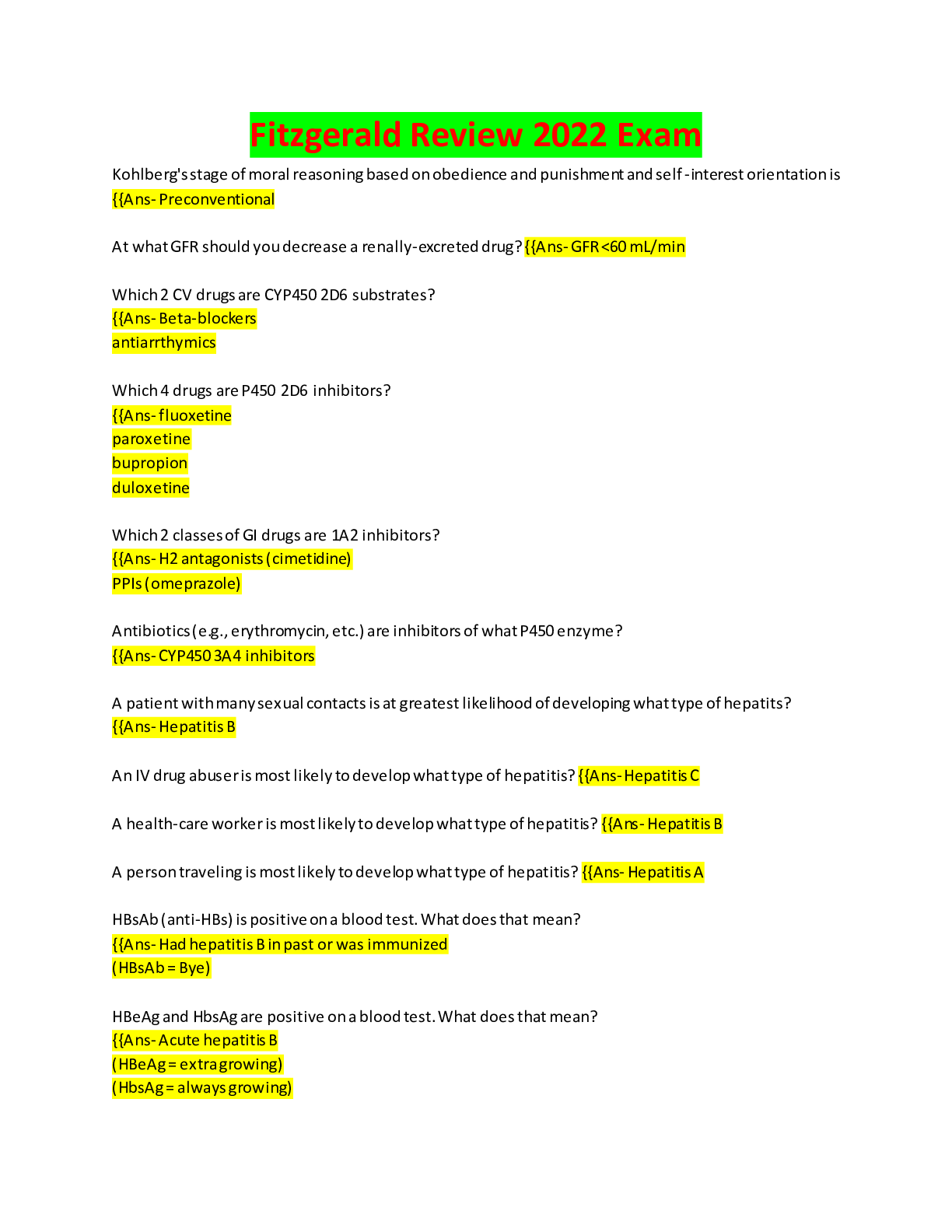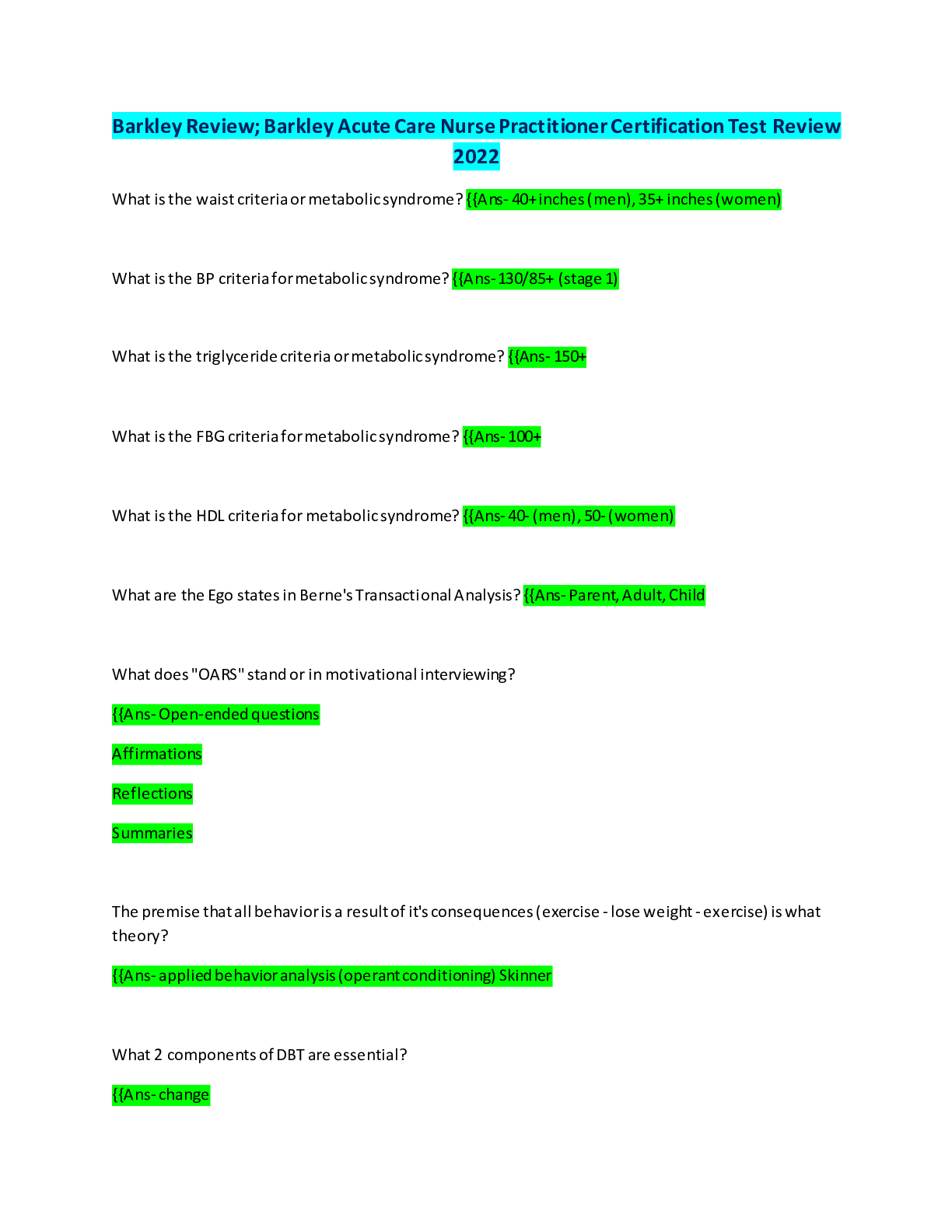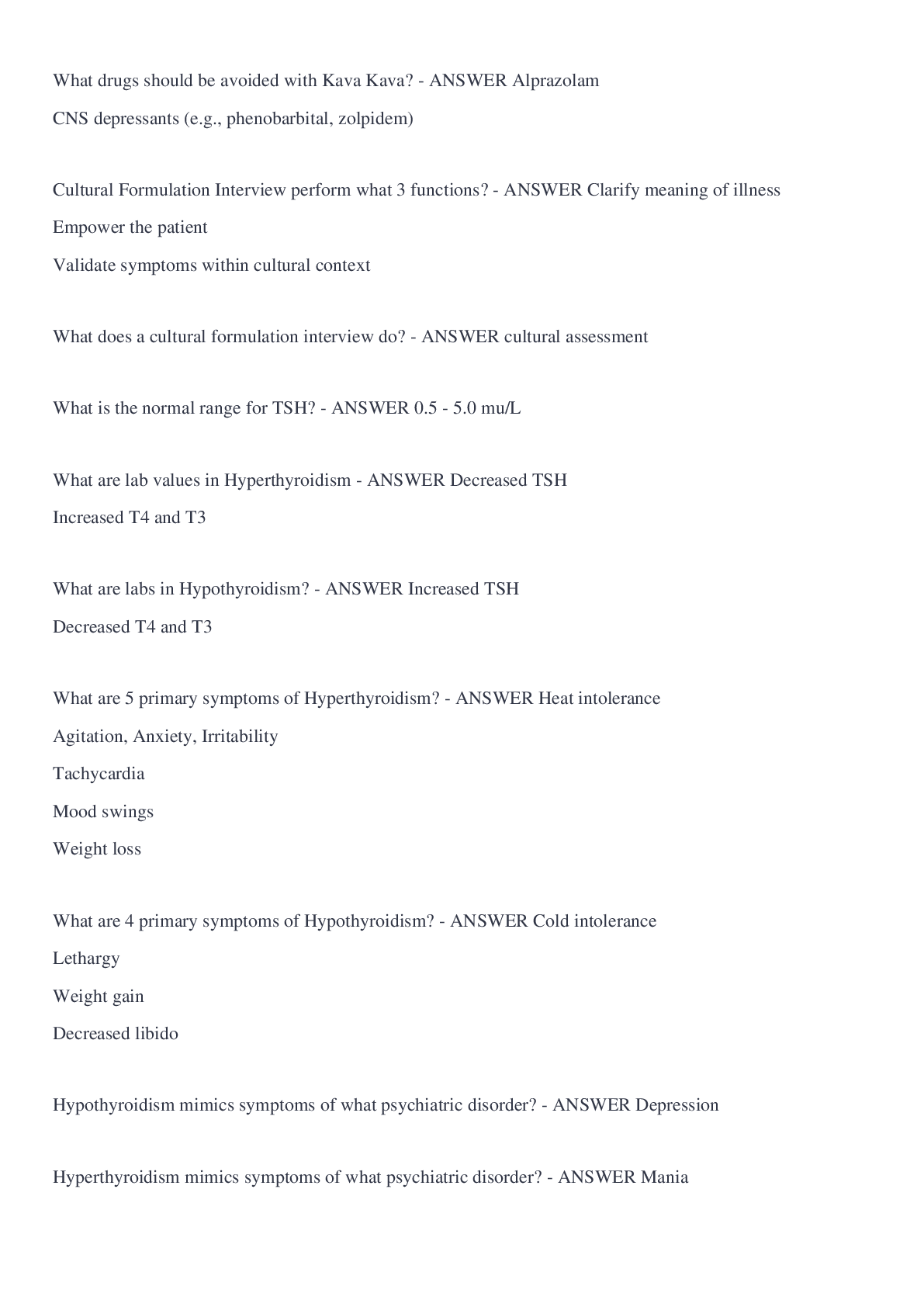*NURSING > EXAM > Barkley Acute Care Nurse Practitioner Certification Exam Review 2022: Liberty University (172QBank) (All)
Barkley Acute Care Nurse Practitioner Certification Exam Review 2022: Liberty University (172QBank)
Document Content and Description Below
Barkley Acute Care Nurse Practitioner Certification Exam Review 2022: Liberty University (172QBank) 1. A 59-year-old is having a follow-up evaluation two years after the successful conclusion of radi... ation therapy for leukemia. He tells you that he has been feeling run-down and reports unexplained weight loss and night sweats. Upon examination, you determine that he also has a fever and pain below his ribs and the left side. You know that he is at risk for chronic lymphotic leukemia. Which of the following results is considered the hallmark of this disease? A. Philadelphia chromosome in leukemic cells B. Lymphocytosis C. Non-circulating blast cells in bone marrow D. Pancytopenia with circulating blasts. 2. A 28-year-old single mother arrives at your office inquiring about alternative options for contraception. The woman mentions that she has been having an oral contraception for the last 10 years but is curious about the hormonal intrauterine device (IUD) option she read about in an article. Which of the following is one of the advantages of using a hormonal IUD? A. Prevention of depression B. Prevention of Asherman’s syndrome C. Increased menstrual loss D. Spotting 3. You are monitoring a toddler who has serous otitis media. The patients want to understand the treatment their child will receive. Which of the following would be the appropriate way to manage this condition?\ A. Oral antibiotics B. Antihistamines C. Decongestants D. Monitor and re-evaluate in 3 months 4. Which of the following seizure patients would most likely benefit from lumbar puncture? A. Any child with a tonic-clonic seizure B. An 11 year old with a fever of 101.5 F C. A four-month-old without fever D. A two-year-old with a known seizure disorder 5. You take a serological test on a patient with hepatitis. Checking over the results, you discover the patient’s serology is positive for the following: surface antigen of the Hepatitis-B (HbsAg), antibody to the antigen of the hepatitis B virus (Anti-Hbe), immunoglobulin M (IgM0, immunoglobulin G (IgG0. What is the proper diagnosis? A. Chronic hepatitis B B. Recovered hepatitis B C. Acute hepatitis A D. Acute hepatitis B 6. Robert, a good friend of your, has called you to advice on obtaining a medical certification. He wants to know his various options. Which statement is true regarding the difference between licensure and certification? A. Certification signifies that a person is qualified to perform a particular role and is granted by a government agency. B. Licensure signifies mastery of specialized knowledge and is granted by a government agency. C. Certification signifies mastery of specialized knowledge and is granted by a non-governmental agency. D. Licensure signifies that a person is qualified to perform a particular role and is granted by a non- governmental agency. 7. A mother brings her 3-month-old baby to your clinic to screen for failure to thrive (FTT). Which of the following is not a sign or symptom that would cause you to associate the infant with FTT? A. Absolute length/width are below the 5th percentile B. Weight falling greater than 2nd percentiles below the standard C. Avoids eye contact D. Commonly cries for more food or milk 8. Which of the following is not true of progestin-only birth control? A. It has excellent reversibility B. It most likely changes tubal transport of female and male gametes C. Its mechanism of action affects the cervical mucus and the endometrium D. It is typically more effective than combination pulls but has more side effects 9. The parents of a 1-year-old patient presents to you with concerns regarding their daughter’s health. At birth, they were told that their daughter had abnormal features and decreased muscle tone. They hope that their daughter would “grow out” of some these defects but, to their disappointment, she has not. They report that their daughter is having trouble walking and sitting up by herself. Furthermore, they state that no matter how much they feed their baby, she is always crying out for more food and, as a result, has been rapidly gaining weight. You suspect a chromosomal condition. Which of the following would be most likely? A. Prader-Willi Syndrome B. Hurler syndrome C. Down syndrome D. DiGeorge syndrome 10. The mother of a toddler complains that her 2-year-old child is picky eater, and despite evidence of a healthy growth pattern, she is concerned about her child’s appropriate food intake. Which of the following is the most accurate regarding toddler nutrition? A. Your toddler’s diet is appropriate if he consumes 70 to 100 kcal/kg/day B. Toddlers should consume more protein and a total of 120 kcal/kg/day C. Toddlers must consume a least 45 kcal/kg/day D. Parent of toddlers should insist that their children clean their plate and consume 100 to 110 kcal/kg/day 11. During a check-up with a 6-year-old, you wish to conduct an interview the child and his parents. He is a new patient, and you want to establish the proper doctor-patient relationship. Which of the following is a necessary component of your interview? A. Assess child’s cholesterol B. Informing the parents ahead of time if you are recording data C. Assess liver function D. Measure the child’s hematocrit 12. According to Jean Piaget, between the age of seven and 11, a child’s psychological development will be marked by: A. Development of intuitive thought B. Capability of logical thought C. Trial and error learning D. Capable of complex problem solving 13. After years of not conceiving, Kelly and Ed finally have a child, a girl named Beverly. They often check with you about what to expect as Beverly ages. In a month she will be 2 ½ years old. Which of the following is typically present in a 2 ½ -year-old child? A. All primary teeth have erupted B. Birth weight has doubled C. Anterior fontanel is open D. The child will be in the industry versus inferiority stage of psychosocial development 14. You are doing a well-child check on an infant. Currently, the baby can lifts his head when on his stomach, laughs aloud, and can crawl to you. When asked to say “mama,” however, the baby just smiles. Based on this description, what is his approximate age? A. 6 months B. 10 months C. 4 months D. 2 months 15. A mother visits you with her 13-month-old daughter, Vicky. The mother tells you that Vicky had Hib conjugate vaccine (Hib) and that she needs her booster. The mother wants to know if Vicky can still get her Hib booster. Which of the following should you tell the mother? A. Hib booster is typically given at 12 months of age. B. Hib booster is typically not recommended until two years of age C. Hib booster must be given in a series of three before 5 months of age D. The child does not need a booster until 5 years of age 16. Maggie, 2-month-old, is planning to receive the polio vaccine. Which of the following statements is true regarding polio vaccine administration to the patient? A. The inactivated polio vaccine would be given at 3, 6, and 9 months of age, with the last dose received by 4 years of age. B. The oral polio vaccine should be started at 6 years old. C. The final dose of the inactivated polio vaccine would typically be given when the patient is 6 years old. D. The inactivated polio vaccine should be given in a single dose at 2 months of age. 17. A parent brings her young infant into the clini, asking questions, about the administration of the rotavirus vaccine to her child. Which of the following is true regarding the rotavirus vaccine? A. The series of doses should begin before 14 weeks of age B. The rotavirus vaccine may be administered before 14 weeks of age C. Feedings should be limited after the child received the vaccine D. The first dose should be administered at 1 year of age. 18. A new mother who is HBsAg-positive has just delivered her first child. Knowing that the baby will need to be protected from hepatitis, what would be your best plan of action for his new born? A. Administer the hepatitis B vaccine and 1.0 mL hepatitis B immune globulin within six hours of birth. B. Administer the hepatitis B vaccine and 0.75 mL hepatitis B immune globulin within 8 hrs of birth. C. Test for HBsAg and antibody to HBsAg immediately after birth D. Administer the hepatitis B vaccine and 0.5mL hepatitis B immune globulin within 12 hrs of birth. 19. Which of the following is not an event that must be reported to the Vaccine Adverse Events Reposting System? A. Anaphylaxis B. Death C. Pneumonia D. Encephalitis 20. You have a patient with a genetic disorder. The physical finding on this patient are an abnormal head, flattened nose, and upward slating eyes. Based on the physical findings, which would be the most likely genetic disorder? A. DiGeorge syndrome B. Down syndrome C. Marfan syndrome D. Turner’s syndrome 21. A 3-month-old infant, who was born healthy and weighed 7 lbs 5 oz at birth, presents with hypotonia, decreased vocalization and suspected seizures, which are all characteristics of Tay-Sachs disease. Which of the following would most predispose the infant to this condition? A. Family history of hyperlipidemia B. Ashkenazic Jewish ethnicity C. African ethnicity D. Family history of drug addiction 22. A 2-year-old female patient has a webbed neck, lymphedema, and low hair line. Additionally, you note the child’s blood pressure to be above the 95th percentile for children her age. The mother also mentions the child has difficulty grasping concepts at home, especially with learning to use a toilet. With which of the following genetic syndromes does the child most likely present? A. Marfan B. Turner’s C. DiGeorge D. Klinefeller’s 23. DiGeorge syndrome causes congenital defects in all of the following except: A. Basal ganglia B. Conotruncal region of the heart C. Parathyroid gland D. Thymus 24. When interviewing an expectant mother regarding family history for the purpose of genetic evaluation, which is not necessary to ask about? A. Neurologic conditions B. Birth defects C. Growth retardation D. Drug addiction 25. You are assessing a newborn who presents with a reddish-purple vascular malformation of the skin consisting of dilated capillaries. You recognize this as which of the following skin variations? A. Café au lait spots B. Port-wine stain C. Strawberry mark D. Mongolian spots 26. A Caucasian newborn delivered via Caesarean section at 38 weeks gestation, without complication, is in the nursery for an initial assessment. As the nurse practitioner, which of the following measurements should you most expect? A. Weight of 1.8 kg, head circumference of 33 cm, and length 52 cm B. Weight of 4 kg, head circumference of 36 cm, and length 51 cm C. Weight of 3 kg, head circumference of 30 cm, and length 50 cm D. Weight of 3 kg, head circumference of 33 cm, and length 51 cm 27. Of the following, which is the appropriate ratio of occurrence of galactoemia? A. 1:3,600 to 5,000 B. 1:400 C. 1:10,000 to 25,000 D. 1:60,000 to 80,000 28. When examining a newborn, which of the following is the best used to diagnose hip dislocation? A. Uneven skin folds B. Allis’ sign C. Ortolani-Barlow maneuver D. Turned in toes 29. A child is born in the 97th percentile for birth weight. It is surprising since the parents are of normal weight and the mother does not have diabetes. This seems to be the infant’s only abnormality, until it is discovered that the child also has an enlarged tongue. Which of the following is the most likely diagnosis? A. Perlman syndrome B. Beckwith-Wiedemann syndrome C. Costello syndrome D. Simpson-Golabi-Behmel syndrome. 30. After giving birth to Tabitha, her first child, 28-year-old Samantha and her husband, Darrin, leave the hospital after a day. The conception was without complication. When should Tabitha come back for a follow-up well-child check? A. Four to six days B. Two to three days C. Three to five days D. One to two days 31. Which of the following is not a supplement typically provided for infants? A. Fluoride B. Vitamin K C. Vitamin D D. Iron 32. A 3-month-old boy with a fever is brought to your clinic by his parents. You take the infant’s temperature and find that it is slightly higher than 101.8 F, which suggests serious bacterial infection, however, you are unable to find the local site of infection. Which of the following should be your next step? A. Prescribe ibuprofen to manage the infant’s condition B. Prescribe alternating doses of ibuprofen and acetaminophen C. Admit the infant to a hospital D. Consider the diagnosis of a urinary tract infection 33. By what age should a child have his first dental visit? A. 2 years B. 10 months C. 8 months D. 1 year 34. Which of the following is a developmental warning sign in infants? A. An APGAR score of nine B. Does not try to pick up a toy by two months of age C. Does not raise head when lying on stomach by 3 months of age D. Does not try to pick up a toy by three months of age 35. Of the choices, which is typically a result of allergic rhinitis? A. Orbital edema B. Mouth breathing C. Fissures at lip corners D. Nasal quality voice 36. A four-year-old boy comes to your office accompanied by his mother, who states that she has been concerned about frequent pauses and repetitions in her son’s speech. After conducting differential diagnosis for hearing and visual impairment, you diagnose the child with stuttering. You assure his mother that no immediate treatment is needed and that stuttering frequently resolves on its own, however, her son may require a future referral. Which of the following conditions would not require a referral? A. The child speaks but has a vocabulary of less than 1000 words B. Avoidance of speaking C. Patient age of six years or older D. Stuttering lasting more than six months 37. The Bayley-Ill test is the standard for the diagnosis of developmental delays in children until what age/ A. 30 months B. 42 months C. 24 months D. 36 months 38. A father brings in his 6-month-old girl, Hannah, because he is concerned that her development has slowed down considerably in the past month. For example, Hannah no longer makes babbling sounds like she used to, and she now drools excessively. She also used to flex her legs and reach for her mother’s hair with her hands, but now her legs and arms are floppy. You eventually diagnose Hannah with a pervasive development disorder that is diagnosed only in females. Which is it? A. Autistic disorder B. Asperger’s syndrome C. Childhood disintegrative disorder D. Rett’s disorder 39. Mary and David bring their child, Sarah, to your office, and they tell you that they want to begin potty training her. The child is showing signs that she is ready to begin her training. Which of the following signs is the nest indicator that she is ready? A. The child’s bowel movement are irregular B. The child’s seems comfortable with wet diapers C. The child can walk and transfer objects between her hands D. The child stays dry after naps 40. A mother brings her 5-year-old son in for a check-up. He is about to enter school for the first time and must go through some screenings before the school will permit him to participate. After reviewing the family history, you learn that his grandfather has a myocardial infarction at the age of 50. Which of the following is specifically indicated by this aspect of the patient’s history? A. Measles, mumps, and rubella immunization B. Purified protein derivative screening C. Cholesterol screening D. Hematocrit screening 41. The parents of 6-year-old Morris are worried about his adjustment to school. He has not exhibited dysfunctional behavior yet, but his older brother, now 20 years old, did. Which of the following is a likely warning sign in younger, school age children? A. Disinterested in any extra academic activity B. Cannot make or keep friends C. Not working to ability D. Destructive behavior to express self 42. When considering a school-age child’s nutritional development, which of the following is not typical average, annual height gain for the child? A. 2 inches B. 1 ½ inches C. 3 inches D. 2 ½ inches 43. A report of suspected child abuse must be made if certain signs or symptoms are observed. Your suspicion of child abuse would be further supported if the child exhibits bruising and the following except? A. Soft tissue markings with the outline of a hand B. Child is beneath 30th percentile for weight C. Partial thromboplastin time of 90 seconds D. Prothrombin time of 11 seconds 44. There are three general strategies when interviewing an adolescent. Which of the following is not one of the strategies used when interviewing adolescents? A. PACES format B. SAFETEENS format C. HEADSS format D. CAGE format 45. A 17-year-old patient, Maria, comes to your office with her mother. You notice, comparing her to last year, she has lost weight and looks very unhealthy. She reports that she has an eating disorder and wants help. You conduct a brief test and find that her teeth look transparent and that she has cotton-like hairs on her arms. It is determined that she has an eating disorder. Which of the following would not be a good management option for Maria’s condition? A. Institutionalization B. Interdisciplinary management C. Behavior modification D. Psychotherapy 46. You are examining a boy whose penis has begun to elongate. The physical development is indicative of what Tanner stage? A. II B. IV C. I D. III 47. When performing a physical exam on an adolescent patient, you should keep in mind that hormone surging can affect which of the following part of the body? A. Tooth eruption B. Motor skills C. Visual acuity D. Liver function 48. Between what Tanner stages does menarche usually occur in girls? A. III and IV B. I and II C. II and III D. IV and V 49. You are checking up on a 6-year-old Arnold, whom you saw last month for strep throat. You want to ensure that this patient is not experiencing a complication that can occur as a result of the strep throat infection after approximately 20 days of the infection. Which of the following would indicate the patient is more than likely experiencing this complication? A. Polymorphous rash B. Inflammatory changes of the lips C. Polyarthitis D. Inflammatory changes of the oral cavity 50. A 14-year-old patient comes to your office showing signs of fever, painful tender joints, and strep throat. Laboratory findings show positive throat culture and a positive rapid strep assay. Based on the findings of this patient, which of the following would not be a good treatment for the patient’s condition? A. Prophylactic antibiotics for invasive procedures B. High dose acetyl salicylic acid therapy C. Aggressive management of the strep infection D. Bed rest if acute carditis is present 51. Kawasaki disease is an acute febrile syndrome that causes vasculitis. It is also known for all the following except? A. A persistent evaluation of average systolic and diastolic blood pressure B. The leading cause of coronary artery disease in children of an infectious etiology C. Occurs most commonly in children of Asia ethnicity D. Most commonly noted in children under the age of two. 52. A diabetic mother, 41 years old bring her 2 week-old male infant into your office. A chest x-ray reveals a boot- shaped heart, with normal size and pulmonary vascular marking. These finding are most indicative of which of the following cardiac defects? A. Tetralogy of Fallot B. Atrial Septal Defect C. Transposition of great arteries D. Ventricular septal defect 53. James and Devin’s first son, Anderson, is diagnosed with Down syndrome. Amongst their many concerns, they want to know if this could affect Anderson’s physical well-being. Down syndrome is associated with heart conditions. Which of the following is the most common heart defect associated with Down syndrome? A. Tetralogy of Fallot B. Patent ductus arteriosus C. Atrioventricular septal defect D. Transposition of the great arteries 54. The nurse practitioner is examining Martin, a 3-month-old whose mother brought in because he has not been gaining weight. A physical examination indicates a palpable olive-shaped mass in the patient’s abdomen. Which of the following would the NP expect to find in Martin’s case? A. Abdominal distention B. Chocking and coughing C. Projectile vomiting after feeding D. Hematemesis 55. You are treating a 1-month-old whose presentation includes jaundice, malnutrition, and distention of the abdomen. His mother adds that the infant experiences infrequent bowel movement and that bile appears in his vomit. Which of the following is the best diagnosis? A. Intussusception B. Hirschsprung’s disease C. Pyloric stenosis D. Appendicitis 56. You have just diagnosed a 10-year-old with gastroenteritis, nut now the parents are concerned that it may have spread to their newborn girl. Since babies cannot tolerate gastroenteritis as long as older children, what symptoms present in the infant should cause the parents to immediately bring their baby to see you? A. The child has a fever of 101F with vomiting B. The child has bouts of colicky pain every evening from 8pm to 8pm C. The child cries with pain, is difficult to comfort, and has diarrhea three times in a day D. The child has bloody stools, no wet diaper in 6 hours, and cries without tears 57. Evan 14-yeard-old presents with complaints of stomach pain that has concentrated in the lower right portion of his abdomen. Evan reports that his abdominal pain worsens when he coughs and that he vomited soon after the pain began, however, he denies any subsequent vomiting episodes. Suspecting appendicitis you begin physical examination and find that Evan experiences pain when he extends his right thigh. This finding is known as: A. Obturator sign B. McBurney’s sign C. String sign D. Psoas sign 58. You are treating Jake, a 2-month-old infant who was born with a low birth weight. Jake’s parents are concerned that he appears to be losing further weight and frequently chokes and wheezes. Additionally, they state that he vomits on a recurring basis. You suspect a diagnosis of gastroesophageal reflux disease (GERD), however, you also know that Jake’s presentation may also be indicative of Pyloric stenosis, and thus, you must conduct laboratory tests to rule out this diagnosis. Which of the following laboratory tests is most helpful in distinguishing GERD from pyloric stenosis? A. Stoof for occult blood B. Urinalysis C. Abdominal ultrasonography D. Complete blood count 59. Max, the infant son of Mel and Anne, has exhibited a red rash on his pelvis due to the type of diaper he wears. Now raised bumps have appeared, although with no discoloration. Which of the following would best treat bumps A. Emollients B. Hydrocortisone C. Topical antifungal D. Domeboro 60. An 18-month-old boy is diagnosed with Coxsackie virus, also known as hand, foot and mouth disease. Which of the following is the most appropriate management for this condition? A. Steroids B. Acetaminophen C. Doxycycline D. Acyclovir 61. In July, Marian brings in her 5-year-old son, Jensen, who has just started presenting with Varicella zoster virus. His contraction of the virus was intentional as Marian brought, Jensen to a “chicken pox party” where a child with the virus can spread it to other kids, so all the children can get the virus now and not when school is in session. Marian asks you for a treatment that specifically reduces the duration of his signs and symptoms. Which of the following is the best recommendation for treatment? A. Antihistamine B. Acetaminophen C. Acyclovir D. Calamine 62. After 3-month-old Jeremy was exposed to pollen found in the backyard, the parents bring him in because of red scabbing on his skin. Which of the following should Jeremy’s parents avoid using for his treatment? A. Topical steroids B. Ultraviolet bright light C. Oil-based products D. Soap and water 63. Which of the following categories of burns present as moist? A. First and second B. First C. Second and third D. Second 64. The father of a 7-year-old bring his child in with complaints of purulent discharge and pain to left ear. Upon examination you notice that the child is to be in pain upon manipulation of the auricle, but the tympanic membrane appears normal and shows evidence of mobility. Which of the following is the most likely diagnosis? A. Acute otitis media B. Serous otitis media C. Otitis externa D. Mastoiditis 65. Jimmy comes to your office for a checkup. During the physical exam, his nose begins to bleed. You begin to apply pressure to which part of the nasal septum? A. Anterosuperior B. Anteroinferior C. Posterosuperior D. Posteroinferior 66. Melissa brings her 10-year-old son Alex for a checkup. His medical history includes corticosteroid treatment for juvenile rheumatoid arthritis (JRA) with which he was diagnosed last month. Melissa was told by the immunologist that Alex would need periodic checkups with an ophthalmologist, however, she notes her son has yet to mention any problems with his eyes. Which of the following should you tell her? A. The inflammation due to JRA often inflames the conjunctiva, causing gradual strabismus. B. The resulting weakened immune system usually leads to recurrent conjunctivitis C. Juvenile rheumatoid arthritis leads to glaucoma D. Prolonged use of corticosteroids may lead to cataracts 67. What are the 2 most common presentations of mononucleosis on the 16 to 20-yeail-old group? A. Fatigue, sore throat B. Swollen lymph nodes, nausea C. Swollen lymph nodes, joint aches D. Fatigue, nausea. 68. An adolescent presents with copious mucopurulent discharge from his right eye. Given the most likely diagnosis, which of the following is the most appropriate first-line treatment? A. Penicillin B. Zithromax C. Ceftriaxone D. Erythromycin 69. You are treating a 9-year-old patient with asthma. Her symptoms, which include coughing and chest tightness, occur three times a week during the day and three times a month during the night. Additionally, she also has a forced expiratory volume in the one second of 80%. Which of the following is the most likely severity level of the asthma condition? A. Mild persistent B. Moderate persistent C. Severe persistent D. Mild intermittent 70. A 1-month-old patient presents with symptoms of chronic cough, nasal passages filled with mucus, and a respiratory infection. You find an obstructive pattern in the pulmonary function test and try to look for more signs to confirm your suspected diagnosis. Which of the following findings, if encountered at sometime, would not help you confirm the most likely diagnosis? A. Fever B. Delayed puberty C. Large, liquid, bulky, foul stool D. Salt-tasting skin 71. You are seeing a 2-year-old who has an upper respiratory infection. Findings include a fever of 102 F, grunting, and prolonged expiration. Based on these signs, which of the following would be the most likely laboratory finding for this patient? A. Slight WBC elevation with eosinophilia B. Abnormalities typical of obstructive dysfunction C. Productive cough D. Chest x-ray with hyperinflated lungs 72. The nurse practitioner conducts a physical exam on a 15-year-old patient presenting with symptoms of respiratory infection. During ausculatation, she hears decreased breath sounds in the right lower lobe. To confirm this finding, she asks the patient to say “EEE” and you hear “AAA”. What respiratory assessment is the nurse practitioner conducting on the patient? A. Type and location of breath sounds B. Egophony C. Testing for heart murmur D. Pulmonary function test 73. Which of the following is not a bacterial pneumonia? A. Klebsiella B. Haemophilus influenza C. Pseudomonas D. Rickettsia 74. Seven-year-old Will is brought to your office after developing a limp. His parents state Will has begun to experience pain in his groin, hip, and left knee since the limp began. Moreover, they express concern about their son’s growth as Will is shorter in stature than most of his peers. Physical examination finding include abduction of the hip joint and passive internal rotation of the hip. Given the patient’s age and presentation, which of the following is the most appropriate form of treatment? A. Limitation of physical activity B. Referral to orthopedics C. Observation D. Analgesics 75. The parents on a 13 year old girl come to your office concerned about the risk of scoliosis in their daughter given a family history of the condition. The daughter is developing asymmetry in her posture and is slightly shorter in stature than most her peers. Which of the following aspects of the patient’s presentation is not a risk factor for scoliosis? A. Age B. Gender C. Stature D. Family history 76. Twelve year old Adam comes to your office after having experienced a recent, sudden growth spurt. He complains of pain in the area just below his right knee and reports tenderness when you apply pressure to the area. These findings indicate which of the following as the most likely diagnosis? A. Osgood-Schlatter disease B. Slipped capital femoral epiphysis C. Toxic synovitis D. Legg-Calve-Perthes disease 77. Which of the following is not a component of the physical examination for developmental dysplasia of the hip? A. Galeazzi’s sign B. Barlow’s maneuver C. Ortalani test D. Adam’s forward bend test 78. A concerned mother brings her four-year-old son, Kevin, to the office. The mother is worried about Kevin’s weakness and clumsiness compared to other children his age as well as his abnormal posture. Further, she notes unusual movements from her son such as moving his hands up his legs when rising to stand. As you begin laboratory testing to confirm your suspected diagnosis, which of the following would you not expect to see? A. Decreased creatine kinase B. Necrotic degenerating fibers C. Abnormal electrocardiogram D. Myopathy 79. Bell’s palsy is associated with the malfunction of which cranial nerve? A. VII B. IV C. VIII D. XII 80. A mother brings her 6-year-old son, Glenn, to the clinic for a check-up. She is concerned that her son constantly says that he smells “peppermint.” Upon physical examination, you notice the child’s mouth starts twitching to the right. After a minute, the twitching stops and Glenn asks why everybody is looking at him. The child is exhibiting signs of which of the following conditions? A. Complex partial seizures B. Clonic seizures C. Simple partial seizures D. Tic disorders 81. A 5-month-old infant is brought to your office by her mother, who states that the infant has lately seemed lethargic and has been vomiting and feeding poorly. Upon examination, you note a bulging fontanel and fever. Which of the following laboratory tests would help confirm your suspected diagnosis? A. Complete blood count B. Computed axial tomography scan C. Erythrocyte sedimentation rate D. Cerebrospinal fluid analysis 82. Sixteen-year-old Jeffrey complains of having debilitating pain once a week. H states that during or after the episodes of abdominal pain, he gets so nauseous that he has to vomit. The results of a stool sample are guiac negative and do not reveal occult blood. Which of the following is the most likely diagnosis? A. Basilar migraine B. Gastroesophageal reflux disease C. Gastroenteritis D. Abdominal migraine 83. You are examining Cody, 8 years old, who has recently begun to experience morning headaches followed by vomiting. Cary states that these headaches have become more frequent since they began. You note numerous findings including head tilt, failure to thrive, and loss of fine motor control. Moreover, Cody tests positive when you administer the Babinski reflex test. Which of the following laboratory tests would not confirm the most likely diagnosis? A. Lumbar puncture B. Magnetic resonance imaging C. Electroencephalogram D. Computerized axial tomography. 84. You are examining a 2-year-old who present with a low grade fever. During physical examination, you note the child is responding as though he has excruciating pain in his back, chest, and abdomen. A lab test reveals his white blood cell count is elevated to 14,000. Which of the following would you also expect to be revealed? A. Poikilocylosis and basophilic stippling B. Howell-Jolly bodies C. Heinz bodies D. Blast cells 85. You have been seeing Larry and Shawna during Shawna’s pregnancy. You did a genotype test for Shawna, but Larry was adopted and, therefore, has no knowledge his biological parents. Now they report that their child has a strange growth on his forehead as well as a pale coloring to his skin. Which of the following is the most likely diagnosis? A. Iron deficiency anemia B. Hemophilia A C. Thalassemia D. Sickle cell anemia 86. You are examining 2-year-old Donald after his parents tell you he has been vomiting and experiencing diarrhea the past week, leading to him losing an alarming amount of weight. Moreover, his gums are blue. During the examination, Donald rapidly jerks his right arm back. When you ask why he did this, he replies that his “arm moved on its own.” Which of the following is the most likely diagnosis? A. Pyloric stenosis B. Lead poisoning C. Appendicitis D. Gastroenteritis 87. While she is pregnant, you discover that Sharon is a carrier for hemophilia A. She asks you what the chance is that she could pass the disorder on to her daughter. Which of the following should you tell her? A. 10% B. 75% C. 25% D. 50% 88. You are seeing a 24-month-old African-American female whose parents complains that she is “unusually tired” however, she has no history of chronic illness. The child’s history reveals that she was switched to whole milk at 12 months and is currently drinking 32 ounces per day. Upon physical exam, you notice pale conjunctiva, and the laboratory results reveal microcytic hypochromic anemia with normal white blood cell (WBC), platelet, and reticulocyte counts. Which of the following is the most likely diagnosis? A. Iron deficiency anemia B. Sickle cell anemia C. Vitamin B12 deficiency D. Alpha-thalassemia minor 89. Eddie, 15 years old, is diagnosed with Type 1 diabetes mellitus (DM). Which of the following would not be a step to take into consideration when managing Eddie’s DM? A. Metformin prescription B. Dietary teachings C. Beginning insulin D. Establishing baseline studies such as family history. 90. Which of the following is not a common cause of hypothyroidism in children and adolescents? A. Pituitary deficiency of thyroid-stimulating hormone B. Hashimoto’s syndrome C. Iodine deficiency D. Graves’ Disease 91. Proportional short stature can be caused by a variety of endocrine diseases. Which of the following is not an endocrine disease that is believes to cause proportional short stature? A. Hypothyroidism B. Chromosomal abnormalities C. Hypopituitarism D. Growth hormone deficiency 92. Abigail, 13 years old presents with muscle cramps, weight loss, and menstrual irregularities. Further, she states that she experiences chest pain and notices moisture on her skin as well as an increased intolerance for heat. Based on the most likely diagnosis, you expect to see decreased levels of which of the following? A. Thyroid stimulating hormone B. Triiodothyronine C. Free thyroxine index D. Thyroid resin uptake 93. Which of the following is not a finding of type 1 diabetes mellitus? A. Dysfunction of peripheral sensory nerves B. Generalized pruritus C. Paraesthesia D. Nocturnal enuresis 94. The parents of 5 year old Brian are worried that he has begun wetting the bed. As you educate them on enuresis, they ask how many children Brian’s age are affected by this condition. What should you tell them? A. 10% B. 20% C. 3% D. 40% 95. Which of the following typically causes urinary tract infections in childhood? A. Urinary stasis B. Escherichia coli C. Obstructive lesions D. Staphylococcus aureus 96. You have assisted Thomas and Myra through Myra’s first pregnancy. The birth of their son, Chad, was uncomplicated, but during the examination of the infant, it was discovered that the boy’s urethra was ventral side of the penis. Which of the following is the least effective cause of treatment? A. Refer to an urologist B. Refer for surgery in six-twelve months C. Do not perform circumcision D. Refer to emergent surgical intervention 97. A mother and her 13-year-old daughter come to your clinic reporting that the daughter complains of painful menstrual cramps and back pain requiring her to miss school several days each month. You suspect a diagnosis of dysmenorrhea. Which of the following is not an example of supportive treatment of this diagnosis? A. Heat application B. Psychological counseling C. Steroidal anti-inflammatory drugs D. Ibuprofen 98. At what age should a child with cryptorchidism be referred to an urologist if the testes remain undescended? A. 9 months B. 1 year C. 2 years D. 6 months 99. Jen comes to your office to inquire about birth control. She explains that she does not want to start a family, she is merely looking for a birth control method that lasts the longest with relatively low maintenance for use. Asking about her medical history, you learn that there have been instances of endometrial cancer in her family. Given this information, which of the following contraceptive options is the best recommendation for Jen? A. Nuvaring B. Depo-Provera C. Intrauterine device D. Oral contraceptives 100. Carolyn, 36 years old asks you about a form of contraceptive that is effective but also easily reversed. You recommend Ortho Evra, which has a failure rate of less than one percent and is a patch that can be removed to end its side effects. What is Ortho Evra’s mechanism of action? A. Causes lysis of the blastocyst B. Prevents implantation due to local foreign body inflammatory responses C. Inhibits ovulation by releasing synthetic estrogen and progestin D. Destroys sperm cells with nonoxynol-9 101. You have just prescribed a diaphragm to Melissa. After informing her of the risks and undesirable side effects, you also educate her concerning how to use it. Of the following, which must be told to the patient regarding proper usage of this contraceptive option? A. The diaphragm must be left in the vagina for at least six hours following intercourse B. The diaphragm must be left in the vagina for at least two hours following intercourse C. The diaphragm must be refitted if the patient gains 10 pounds D. The diaphragm must be left in the vagina for at least 4 hours following intercourse 102. Now that she is married, Riki is interested in birth control method that is easy to use and effective. She expresses particular interest in the Depo-Provera (DMPA) shot, its first year failure rate of only 1% to 2% is attractive to her. To provide a clear and thorough description of DMPA use, however, you should inform her of some of the disadvantages of the use of DMPA, including: A. Reduced effectiveness when used with certain antibiotics B. Delayed return of fertility C. Pain and cramping may accompany use D. Weight gain 103. A 43-year-old diabetic patient visits your office requesting a birth control prescription. During the physical assessment, you learn that she has well-controlled type 1 diabetes, which she claims is the result of using an insulin pump. Based on her medical history, which of the following is the least desirable birth control method? A. NuvaRing B. Oral contraceptives C. Ortho Evra D. Intrauterine device 104. A vacuum D and C surgery can be performed until which of the following? A. 24 weeks B. 16 weeks C. 20 weeks D. 12 weeks 105. An excited expectant mother comes into your office for her first obstetrics visit. While interviewing her for a thorough history, she asks you when she should expect the child. When you ask when was her last menstrual period, she replies March 7, 2013. Which of the following is the best approximate estimate of the patient’s due date? A. November 29. 2013 B. December 10, 2013 C. December 8, 2013 D. December 14, 2013 106. A female patient comes into your office for a physical examination. Her vitals are normal but she complains of feeling nauseous as of lately. While you conduct the physical examination, you note that her cervix has a bluish tint. Which of the following does this finding most likely indicate? A. Cervical cancer B. Uterine cancer C. Urinary tract infection D. Pregnancy 107. During a routine obstetrics visit for her 15th week of pregnancy, a 40-year-old pregnant woman that her husband had a nephew with Down syndrome. Between her age and Down syndrome’s hereditary nature, she wonders if it is possible to know whether her child will have the syndrome. Which test could you currently administer to this patient to test for Down syndrome? A. Triple screen B. Amniocentesis C. Biophysical profile D. Quad screen 108. An 8-week pregnant patient comes into your office with complaints of brown blood she say in her underwear, pelvic pain, and lower back pain. You conduct a physical examination and elicited complaints of tenderness of the cervix. Additionally, you also note uterine enlargement. Of the following, which tests should you conduct to diagnose the most likely condition? A. Triple screen B. Quad screen C. Qualitative serum HCG measurement D. Quantitative serum HCG measurement 109. Charlie, 26, complains of fever, headache, and malaise. Since it is cold and flu season, you suspect that he may have the flu. You administer a throat, swab, which is negative for bacteria. Among the following choices, which would you not recommend for his treatment? A. Oseltamivir B. Ceftriaxone C. Antipyretics D. Zanamivir 110. Your patient, Carl, is in your office for an examination. When undergoing the physical exam, his nose starts to bleed. Carl says he thinks the weather is causing him to have more and more frequent nose bleeds. If Carl’s nosebleed is not an atypical incidence, from which of the following sites would you most expect the nose bleed to originate? A. Vestibular fold B. Naspharynx C. Posterior septum D. Anterior septum 111. After performing an eye exam on 38-year-old Megan, who was recently diagnosed with type 2 diabetes, you conclude that she is at risk for retinal vein occlusion. While performing a fundoscopic exam on Megan, how should normal retinal veins compare to arteries? A. Veins and arteries are equal in width, but the veins are darker than the arteries in color B. Arteries are less bright and wider than the veins C. Veins and arteries are the same shade of color, but the veins are narrower than the arteries D. Arteries are a brighter red and narrower than the veins 112. Which of the following is not a treatment for otitis externa? A. Nosteroidal anti-inflammatory drugs, topical corticosteroids for pain control B. Cleansing and debridement of the ear C. Antiemetic D. Topical otic drops 113. An 18-year-old girl presents with fever, drastic weight loss, and a general feeling of malaise. During an otoscopic exam, you find white tonsillar exudates. Upon physical examination, you notice a mass in the girl’s upper left quadrant. What tests should you order to confirm the most likely diagnosis? A. Oral culture B. Throat swab C. Computed tomography scan D. Monospot 114. Jo arrives with itchy patches of sharply defined red spots on her hands. Her husband works at a chemical plant, and she handles his laundry. You have diagnosed her with allergic contact dermatitis. Which of the following would not be prescribed to the patient? A. Topical steroids B. Prednisone taper C. Oral antihistamines D. Not scrubbing with soap and water 115. Charles has a condition developing on his arms. You see areas of elevation of the skin that are larger than 1 cm in diameter, flat, and resemble psoriasis. Which of the following terms best fits this description? A. Bulla B. Plaque C. Patch D. Vesicle 116. Parker, a 35-year-old male. Comes to your clinic demanding an antidote for a spider bite. He states that he has already become feverish. You check his arm and see a red swollen boil, and you ask him when he was bitten. He responds, “I don’t know, it must have been while I was asleep.” After reviewing his history, you learn that he was recently hospitalized. This leads you to suspect that his condition is not a spider bite but rather a type of skin infection. Which of the following treatment would be best to prescribe first? A. Clindamycin B. Topical erythromycin C. Metronidazole D. Tetracycline 117. Going into summer, 54-year-old Elaine is excited to show off her new, skinnier shape. She is more distressed than usual when she comes to your office complaining of “red circles” on her skin. Upon assessment, you notice that these circles are only on her arms and legs, and are dry and scaly. Given this classic presentation, which of the following antifungals should you prescribe her? A. Metronidazole B. Itraconazole C. Miconazole D. Griseofulvin 118. You have been treating 18-year-old Timothy with an oral antibiotic for his moderate acne. He was excited that his long battle with acne might be over, but now he returns to your office for a checkup and is depressed. His condition did not improve, rather it seems to have worsened somewhat. You decide to prescribe a topical antibiotic as well. Which of the following topical antibiotic is the most frequently used for the treatment of acne? A. Metronidazole B. Clindamycin C. Erythromycin D. Tetracycline 119. Which of the following medication for type 2 diabetes mellitus is an alpha-glucosidase inhibitor to specifically reduce glucose levels? A. Acarbose B. Glipizide C. Sitagliptan D. Repaglinide 120. Thirty-seven-year-old Fred presents with complaints of acne, sudden weight gain, and excessive hair growth. Upon examination, you note purple striae and a blood pressure reading reveals that Fred is hypertensive. Based on the patient’s findings, you order laboratory tests to confirm your suspected diagnosis. Which of the following laboratory findings you would not expect to see? A. Hyperkalemia B. Hyperglycemia C. Hypernatremia D. Glycosuria 121. You are examining a patient whose blood pressure is 140/85 and triglycerides read 140 ng/dL. Moreover, upon physical examination, you find that his waist is 44 inches. Based on these findings you suspect metabolic syndrome and educate the patients on his condition. Which of the following statements is not correct information to give to him? A. Metabolic syndrome is indicated high-density lipoprotein is less than 40 mg/dL B. Metabolic syndrome is indicated by fasting blood glucose greater than 100 mg/dL C. Metabolic syndrome usually leads to Type 2 diabetes mellitus D. Metabolic syndrome usually leads to Type 1 diabetes mellitus 122. You are seeing a patient who has recently been diagnosed with hyperthyroidism and are educating him on the causes of this condition. You should tell the patient all of the following except? A. Grave’s disease is the most common presentation of hyperthyroidism B. Onset of hyperthyroidism most commonly occurs between 20 and 40 years of age C. Iodine deficiency typically causes hyperthyroidism D. Hyperthyroidism is more common in women than in men by an 8:1 ratio 123. Harold, a 63-year-old diabetic, is reporting problems with elevated blood sugar during the morning, typically when he wakes up. He is unsure as to what the problem is because he tests his blood sugar every night before going to bed and his results are supposedly within normal ranges. Problems with early morning hyperglycemia are not uncommon to diabetics, and you suspect Harold’s case is no different. If Harold’s hyperglycemia is not the result of any external circumstances, such as having a sugary snack upon waking, Harold would have a hypoglycemic blood sugar at which of the following times? A. 5:00 am B. 7:00 am C. 1:00 am D. 3:00 am 124. A 24-year-old female comes to your office complaining of pain along the buttocks, the side of her leg, and the side of her ankles. You ask her to flex her foot and you find a weakness of plantar flexion in her foot and great toes. You tap her Achilles tendon while her foot is dorsiflexed, to which you elicited a weakened response. Which of the following should you ask the patient to do to screen for the most likely disk pathology? A. Walk on the heels of her feet B. You are treating Bruce 38 year old who was confirmed positive for HIV. Bruce now returns to your office with fever and a Squad and rise C. Walk on her toes D. Motion her ankle in a “circle 8” 125. Wilma, a 63-year-old with osteoarthritis is complaining of pain and stiffness in her joints. Which of the following statements is most likely true regarding Wilma’s current state? A. “It’s better in the morning, but it worsens as the days goes on” B. “It’s worse in the morning but it gets better as the day goes on” C. “Corticosteroids may help her condition D. “Resting does not help the pain at all” 126. You just referred 19-year-old Emily for a cast on her sprained ankle. Which grade of ankle sprain would she have to necessitate a referral? A. Grade 2 B. Grade 5 C. Grade 3 D. Grade 4 127. Which of the following, if found, would help differentiate rheumatoid arthritis from osteoarthritis? A. Nodes in the proximal interphalangeal joints B. Swelling and edema C. Nodes in the metacarpophalangeal joints D. Node in the distal interphalangeal joints 128. A 32-year-old man comes to your office limping and complaining of pain in his knee. He had been playing basketball and he believes that he hurt it after a particularly unruly game. You flex his knee 90 degrees, put pressure on his heel with one hand, while rotating the lower leg internally and externally. Which of the following tests have you performed? A. Apley’s grind test B. Phalen’s test C. Lachman’s test D. McMurray’s test 129. You are treating Bruce, 38 years old, who was confirmed positive for HIV. Bruce now returns to your office with fever and a non-productive cough. Moreover, he complains of shortness of breath and states that he has begun to experience unintentional weight loss and night sweats. Based on Brice’s signs and symptoms, you suspect a diagnosis of AIDS. Which of the following laboratory tests would confirm this diagnosis? A. CD4 count B. Western Blot C. ELISA D. Gram stain 130. John, a 21-year-old male, is a college student who comes to your office complaining of painful urination. He reports that this morning he was “grossed out” when he saw yellow and green penile discharge. A gram stain of the discharge shows gram-negative diplococcic and white blood cells. Which of the following is the best treatment for John’s condition? A. Cryoanesthesia B. Benzathine penicillin C. Ceftriaxone D. Podophylin 131. A high school girl comes to your office for a checkup. You begin a standard exam, but she immediately asks you about HIV transmission. She mentions that, though she has never had intercourse, she is worried because she has recently engaged in what she considers risky behavior. Given the most current literature, what should you tell the girls is the least likely mode of transmission for HIV? A. Vaginal intercourse B. Anal intercourse C. Kissing D. Oral Sex 132. After experiencing joint pain and loss of hair both on his head and in random parts of his body, 43-year-old Gregg comes to your office. During questioning, he also reveals a lack of appetite, and a general feeling of discomfort and unease. The patient reports having unprotected sex with a stranger sometime before his symptoms occurred and is worried that he may have a sexually transmitted infection. You conduct a microhemagglutination assay, which returns positive for the antibody to Treponema palladium. Which of the following drugs should be used in the plan of care? A. Ceftriaxone B. Penicillin G C. Gardasil D. Acyclovir 133. You know Debbie because you treated her mother for breast cancer last year. Now she comes in complaining of discomfort and pain in her pelvic area. She has reentered dating life after withdrawing from it for a year because of her mother’s situation. She has no desire to eat, and she looks as if she has lost weight since her last visit. Which of the following test is least likely to reveal the source of Debbie’s pelvic pain? A. Culture and Gram stain B. Mammography C. Pregnancy test D. Pap test 134. You are performing a dual-energy x-ray absorptiometry (DEXA) on Katherine, a 42-year-old Asian female who is experiencing early menopause. She has requested a DEXA to screen for osteoporosis. In the process of conducting a DEXA, the measurement that compare the patient’s bone density to the average bone density of control subjects who have peak bone density is: A. T-score B. C-score C. D-score D. Z-score 135. You are treating 22-year-old Shoshanna, who admits to your that she has never had sex. You know that the administration of a Papanicolau test (Pap smear) should start three year after a patient has become sexually active, however, if a female has not yet had sex, like Shoshanna, the administration of Pap smears should begin or should have begun? A. When she was 16 B. Three years from now C. When she was 13 D. A year ago 136. David, a 42-year-old, lives alone. He comes in complaining of lower back pain, fever, and testicular pain. He shows signs of scrotum edema. Although this condition is usually caused by Chlamydia, you know that is not the cause here. Which of the following is the most likely cause in this case? A. Septicemia B. Neisseria gonorrhoeae C. Bacterial prostatitis D. Bacterial ascension from the bladder 137. A new patient of yours is extremely concerned about developing osteoporosis. She has come to you to learn of there are any effective ways to increase calcium in her diet. Which of the following options would be the least helpful addition to her diet? A. Tofu B. Broccoli C. Tump greens D. Sardines 138. You are counseling a couple who is employing a surrogate to carry and deliver their baby. They are concerned because their surrogate has developed strange food cravings, including a craving to eat clay. Which of the following results drawn from the surrogate would be most expected if her condition was the results of hemoglobinopathy? A. Low hemoglobin and high total iron binding capacity B. Low hemoglobin and normal total iron binding capacity C. Low hemoglobin and normal ferritin D. Low hemoglobin and serum ferritin is high 139. A 59-year-old male is having a follow-up evaluation two years after the successful conclusion of radiation therapy for leukemia. He tells you that he has been feeling run-down and reports unexplained weight lost and night sweats. Upon examination. You determine that he also has a fever and pain below his ribs on the left side. You know that he is at risk for chronic lymphocytic leukemia. Which of the following results is considered the hallmark of this disease? A. Non-circulating blast cells in bone marrow B. Philadelphia chromosome in leukemic cells C. Lymphocytosis D. Pancytopenia with circulating blasts 140. A 24-year-old patient presents to your office with complaints of fatigue, headache, and a recent onset of a very pale complexion. Upon examination, you note her tongue appears very smooth and has an absence of papillae. When you question the patient about her diet, she tells you that she frequently skips meals and tends to eat fast food on the times when she does eat. What is the most likely diagnosis? A. Folic acid deficiency B. Sickle cell anemia C. Anemia of chronic disease D. Pernicious anemia 141. Upon the conclusion of a 30-year old woman’s examination, you have chosen to prescribe oral ferrous sulfate. This type of therapy is the mainstay of treatment for which of the following? A. Sickle cell anemia B. Pernicious anemia C. Iron deficiency anemia D. Folic acid deficiency 142. An African American man enters your clinic complaining of weakness, dyspnea, and a sudden onset of severe pain in his back, chest, and extremities. Lab test show decreased hemoglobin, and his history reveals sickle cell anemia. Which of the following would you not order as a course of treatment? A. An antibiotic B. Fluids C. Oxygen D. Analgesics 143. You specialize in caring for the elderly and are concerned about a recent spike of suicides in the elderly community. What are the two major reasons that the elderly commit suicide? A. Poor support systems and future uncertainty B. Medical disability and loneliness C. Dementia and overmedication D. Financial instability and lack of access to care 144. A caretaker is taking an Alzheimer’s patient for a walk and hands him his jacket. However, the patient merely looks back at the caretaker and stares, as though he is confused. What should the caretaker do? A. Put the jacket on the patient B. Remind the patient by telling him to put his jacket on again C. Assume that the patient doesn’t need that coat and continue the walk, carrying the coat D. Cancel the walk and reschedule for another time 145. Your patient has a history of alcoholism in his family. He is concerned by this history and asks for your advice. Which of the following is a false statement regarding alcoholism and family issues? A. Alcoholism is a treatable disease B. Al-Anon is a psychotherapy program for families of alcoholics C. Behavioral approaches to management are usually useful D. Alcoholics Anonymous is an effective evidence-based 12-step program for alcoholics 146. You are caring for a patient with Alzheimer’s disease. Which of the following is most helpful in assisting with memory impairment while improving cognitive clarity? A. Trihexiphenidyl (Artane) B. Donepezil (Aricept) C. Pramipexole (Mirapex) D. Valporic Acid (Depakene) 147. Scientist do not yet fully understand what causes Alzheimer’s disease, but it is clear that this disease develops because of a complex series of events in the brain over a long period of time. The likely causes of Alzheimer’s includes genetic, environmental, and lifestyle factors. One theoretical cause is an improper balance and function of neurotransmitters in the brain. Which of the following conditions is considered a casual factor of this aspect? A. Dopamine deficiency B. Acetylcholine deficiency C. Serotonin excess D. Excessive norepinephrine 148. Daniel, a 57-year-old male, presents to your office with a slow but noticeable tremor. He complains that the tremor gets worse whenever he is particularly stressed. He also states that his body has become increasingly rigid and that he is having difficulty swallowing. You notice that Daniel’s blinking very slowly and inconsistently, but, when you tap the bridge of his nose repetitively, he responds with sustained blinking. Of the following disorders, which would best account for Daniel’s condition? A. Multiple sclerosis B. Parkinson’s disease C. Trigeminal neuralgia D. Bell’s palsy 149. You are about to perform diagnostic tests on Shannon, a 34-year-old with multiple sclerosis. Before you initiate your assessment, you engage in a brief conversation concerning her disorder and the laboratory examinations that surround it. Of the following statements, which is incorrect regarding laboratory diagnostics of multiple sclerosis? A. An edrophonium test can be administered as a differential diagnostic B. Laboratory diagnostics can never be definitive for multiple sclerosis C. Laboratory diagnostics often find an increase in the number of lymphocytes circulating in the blood D. Slightly elevated protein levels can be found in the cerebrospinal fluid 150. A patient with a history of headaches is taking propranolol. However, it is noted that she does not have hypertension or anxiety, which propranolol is often used to treat. Given this information, which of the following is the most likely reason that she is on propranolol? A. To improve alertness during headache attacks B. To lessen the severity of migraine headaches C. To prevent macular degeneration as a result of chronic headaches D. To diminish the recurrence of migraine headaches 151. Mark is admitted after experiencing a short, 30-second seizure. Five minutes later, his girlfriend, who admitted Mark, said that he went in and out of consciousness. During this time, Mark did a lot of “lip smacking,” which is not normal for him. Which of the following classifications best fits the description of Mark’s seizure? A. Simple partial B. Grand mal C. Petite mal D. Complex partial 152. Which of the following is a steroid option for patients with Bell’s palsy? A. Benztropine B. Sumatriptan C. Acyclovir D. Prednisone 153. Ruth, 39 years old, comes to your office complaining of a bitter taste in her mouth, a “burning” feeling in her chest, and excessive salivation. She states that these symptoms occur mostly at night. Based on these symptoms, you suspect a diagnosis of gastroesophageal reflux disease. Which of the following would not be given as initial treatment? A. Cimetidine B. Sodium bicarbonate antacid C. Dexlansoprazole 154. Fifty-year-old Patrick presents with complaints of intense pain in his right upper abdomen that radiates to his shoulder. He also states that he has recently begun vomiting which gives him some relief from his pain. Upon physical examination, you find that Patrick has and elevated temperature and a positive Murphy’s sign. Which of the following would be the most effective test to confirm your suspected diagnosis? A. Sigmoidoscopy B. Ultrasound C. Endoscopy D. Computerized tomography 155. Twenty-year-old Clayton comes to your office complaining of attacks of acute pain in his stomach. Clayton states that his pain has concentrated in the lower right corner of his abdomen since onset. Based on the patient’s presentation, you suspect a diagnosis of appendicitis. Which of the following signs would not confirm the diagnosis? A. Obturastor sign B. Rovsing sign C. Murphy’s sign D. Psoas sign 156. Your patient complains of experiencing continuous bouts of bloody diarrhea for the past three months. A sigmoidoscopy confirms ulcerative colitis. Which of the following is not utilized in the management of this condition? A. Mesalamine suppositories B. Colectomy C. Hydrocortisone suppositories D. Broad spectrum antibiotics 157. Horace, a 60-year-old male, states that he has been experiencing frequent gnawing stomach pain that worsens with eating. Furthermore, while at a dinner party the night before, Horace has to excuse himself from the table because of severe stomach pain. This history is specifically associated with which of the following conditions? A. Gastric ulcer B. Duodenal ulcer C. Gastroesphageal reflux disease D. Gastroenteritis 158. You have diagnosed your 70-year-old patient with pneumonia. You note from her history that she is also diabetic. Which of the following medication regimens would be most appropriate? A. Amoxicillin/Clavulante plus Clarithromycin B. Levaquin plus doxycycline C. Cefpodoxime plus moxifloxacin D. Azithromycin plus clarithromycin 159. You have a patient who presents with a number of respiratory symptoms. He has a temperature, and, upon auscultation, you hear crackles. You believe your patient has either pneumonia or acute bacterial bronchitis. Which of the following signs and symptoms would confirm a diagnosis of pneumonia? A. Malaise B. Consolidation in the lungs C. Purulent sputum D. Chills 160. An 18-year-old female comes to your office two weeks before she is going to begin her first semester at college. She is anxious but also excited, especially to be living in the dormitories. To be able to live there, though, she needs to provide proof of a negative tuberculosis (TB) test. According to her results, however, she has an active TB infection and needs to begin treatment immediately. You tell her that if the condition proves susceptible to her medication regimen, the initial course of the medication could last for: A. Two months B. Six months C. One month D. Nine months 161. A patient of yours has poorly controlled chronic asthma. His history indicates that he is taking inhaled corticosteroids for treatment. Which of the following additional medications would be most effective for the maintenance of chronic asthma? A. Fenoterol B. Albuterol C. Rifampin D. Montelukast 162. A 37-yesr-old patient presents with dyspnea and sputum production. His history indicates that he has been smoking for the past 15 years. Which of the following additional finding would help the nurse practitioner diagnose the patient’s condition as chronic bronchitis? A. Productive cough for three consecutive months in the past two years B. Mild, clear sputum C. Blunting of shadowing of the costophrenic angle D. Increased of chest anteroposterior diameter 163. You are visited by 29-year-olod Henry who has previously had tachycardia. Upon physical exam, you hear a low-pitched rumble that occurs during the first heart sound. Of the following conditions, which is the most likely diagnosis? A. Aortic regurgitation B. Mitral stenosis C. Mitral regurgitation D. Aortic stenosis 164. Brian, 42 years old, presents complaints that his extremities get cold, furthermore, he states that he is experiencing calf pains and that his pain progresses when he is at rest. Upon examination, you find ulcers, dependent rubor, and shiny, hairless skin on his legs. Additionally, you find that the patient has dependent rubor in his physical exam. Which of the following is the most likely diagnosis? A. Deep thrombosis B. Chronic venous insufficiency C. Peripheral vascular disease D. Superficial thrombosis 165. Andrew presents with complaints of chest pain. He states that this pain lasts several minutes at a time and is accompanied by breathing difficulty. Physical examination findings include a positive Levine’s sign as well as a transient fourth heart sound. Based on your suspected diagnosis, you know that all of the following electrocardiogram reading would confirm this diagnosis except? A. Elevation of ST segment B. Downsloping of ST segment C. T wave peak D. T wave inversion 166. Sixty-nine-year-old Monica presents with aching and night cramps in her legs. However, Monica states that her pain goes away when she raises her legs. Upon physical examination, you note the presence of edema stasis leg ulcers in Monica’s legs and that her leg is cool to the touch. Which of the following is the most likely diagnosis? A. Peripheral vascular disease B. Superficial thrombosis C. Deep thrombosis D. Chronic venous insufficiency 167. Your patient’s history indicates that his heart has deficient cardiac output after a myocardial infarction. The patient complains of a wheezing, frothy cough, and appears generally healthy now after the infarction. The patient, however, also has difficulty breathing while at rest. Upon auscultation, you hear a S3 gallop. The patient also tells you that he is unable to carry out any physical activity without incurring symptoms. How should you classify the patient’s condition? A. Chronic heart failure B. Class I heart failure C. Class IV heart failure D. Class II heart failure 168. You are treating a patient who is receiving hospice care following inpatient treatment for cancer. Which of the following types of Medicare does not include home coverage? A. Medicare A B. Medicare B C. Medicare D D. Medicare C 169. You are treating a Guatemalan patient who speaks only Spanish. According to the standards of Culturally and Linguistically Appropriate Services, it is necessary to provide all of the following for the patient except: A. Interpreters B. Verbal and written notices in the patient’s preferred language C. Family members and friends who are present to assist with interpretation D. Bilingual staff 170. You are treating a schizophrenic patient whom you suspect is a danger of hurting himself and/or others as a result of his condition. Under which of the following procedures are you required to administer proper treatment to the patient? A. Involuntary commitment B. Report the patient to the health department C. Crisis intervention D. Use of restraints 171. You are treating a patient who requires surgery and are ensuring that measures are taken to prevent harm being done to the patient. Which of the following key ethical principles is associated with this duty? A. Beneficience B. Utilitarianism C. Nonmaleficence D. Justice 172. You are treating a patient who dies unexpectedly following a surgical following a surgical procedure. As a nurse practitioner, in which of the following components of the investigation are you most likely to take part to assess the incidence? A. Risk management B. Experimental research C. Root cause analysis D. Quality assurance [Show More]
Last updated: 2 years ago
Preview 1 out of 26 pages
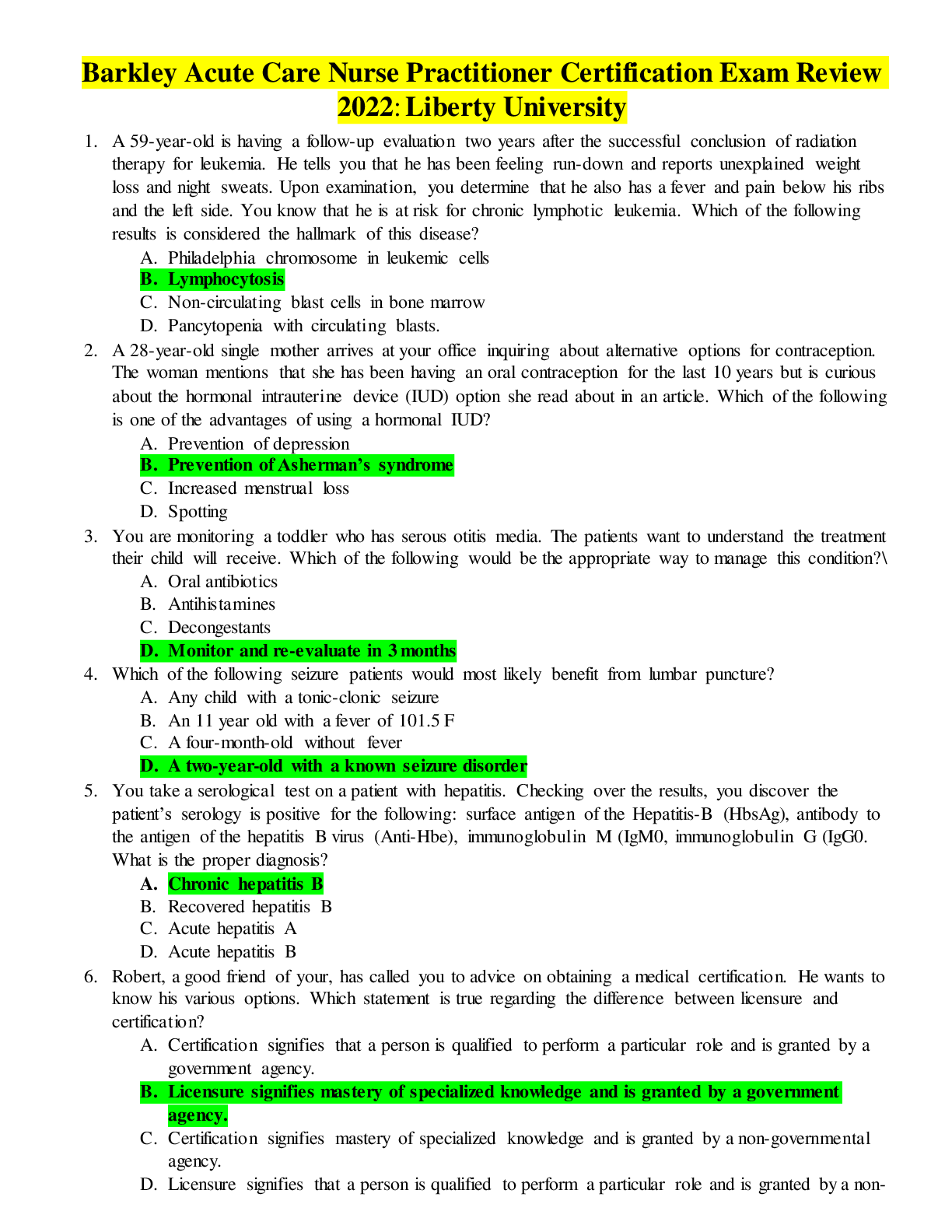
Buy this document to get the full access instantly
Instant Download Access after purchase
Buy NowInstant download
We Accept:

Reviews( 0 )
$13.00
Can't find what you want? Try our AI powered Search
Document information
Connected school, study & course
About the document
Uploaded On
Jun 23, 2022
Number of pages
26
Written in
Additional information
This document has been written for:
Uploaded
Jun 23, 2022
Downloads
1
Views
376

